
In 2022, my family of four spent $10,209.68 on groceries. That averages out to $850.81 per month, which is $212.70 per person. We are two adults (ages 39 and almost-39) and two kids (ages 7 and 5). Today I bring you an exposé, a deep dive into what we eat, where we buy it, how we prepare it and how much we spend on it. Ever wondered what I eat? Wonder no more!!!
Do You Actually Know What You Spend on Food?
I walk around with an idea in my mind about what we eat and how much we spend on it, but I wanted to interrogate that assumption. Did I actually know what we spent last year? And how much that was per person? NOPE I did not. Despite rigorously tracking our spending with Personal Capital each month–and sharing it here on Frugalwoods for the world to judge–I haven’t been in the habit of tallying up our annual expenses by category.

I know what we spend in a year, but I hadn’t done the granular breakdown. And what could be more illuminating, more tantalizing than knowing what we spent on FOOD?! It’s the frugal hallmark, it’s the encapsulation of the cliche “you are what you eat,” coupled with my personal favorite cliche “how you spend your money dictates the type of life you’ll lead.”
Groceries and menu planning are the most commonly discussed topics amongst Frugalwoods readers.
I know this because they come up in:
- My inbox and DMs
- The private Frugalwoods Facebook group
- The UFM Mastermind Groups
- Almost every single one-on-one financial consultation I conduct
- Nearly every on-the-blog Reader Case Study
- Just about every single hourlong (and 1/2 hourlong) phone call I have with one of you fine peoples
→It’s omnipresent because we must eat.

Groceries are the prime example of a “Reduceable” expense. When looking at someone’s spending, I like to categorize everything as either Fixed, Reduceable or Discretionary:
- Fixed expenses are things you cannot change. Examples: your mortgage and debt payments.
- Reduceable expenses are necessary for human survival, but you control how much you spend on them. Examples: groceries and gas for the cars.
- Discretionary expenses are things that can be eliminated entirely. Examples: travel, haircuts, eating out.
The Venn Diagram of Frugal and Healthy

As you will note, I do not have the cheapest, most bare bones food budget. Rather, I try to hit the intersection of frugal, healthy and delicious. I can’t put a price on my health–or my husband’s or children’s health–so I do indeed spend more on foods we view as healthy.
Q: Liz, do you think you’re a nutritionist?
A: No, I do not. I know our diet is imperfect, but it works for us.
As you can see in the below Venn Diagram (which I 100% made up… ), the goal for me is to hit the crossover point where I feel like we’re getting “healthy” foods–the kales of the world–but avoiding the most expensive ways to deliver these kales into our lives.
Here’s an example: at our warehouse store BJ’s (akin to Costco or Sam’s Club), I buy 1 lb of ORGANIC generic super greens (kale, spinach, etc) for $4.99. FOUR DOLLARS & NINETY-NINE CENTS (this would be so much easier if they just charged $5…). Were I to purchase this at Whole Foods or our local Coop, I’d spend double that for a smaller container. This is what I’m talking about when I caution against expensive grocery stores!
Our Grocery Shopping List by Store
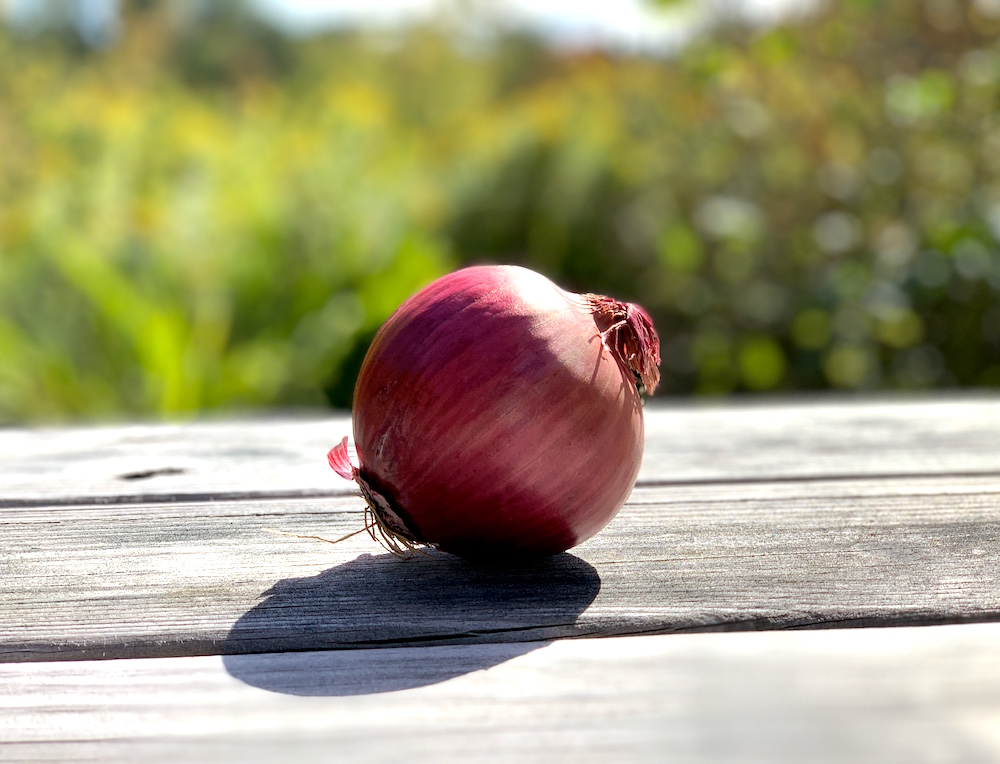
I initially wrote out this list–and meal plan–at the request of one of my private financial consultation clients. She wanted to see what we eat and buy and so, I tried my best to write down everything we eat and where we buy it.
We shop approximately twice a month and don’t buy all of this stuff each time. Rather, this is the total overview of everything we buy and our bi-weekly lists change as needed. Plus, this doesn’t account for specialty meals, such as at Christmas and for birthdays. The cost spreadsheet (below) does include those meals, but I didn’t put the ingredients here since they’re infrequent and sporadic.
Q: Liz, are you aware there’s a lot of privilege in having the time and money to buy bulk, raw ingredients and cook them from scratch?
A: Absolutely, which is why I contextualize this as what I do and what works for my family. I cannot combat systemic economic disparities, much as I would like to.
Ok, here’s our list divided by source:

Purchased from the Co-op (ordered from their bulk department roughly once a quarter, see spreadsheet for precise dates):
- Organic Rolled Oats, 25lb bag (what we eat for breakfast)
- Organic White Whole Wheat Flour, 50lb bag (what we bake our bread with)
- Dried Garbanzo Beans, 25lb bag (what we make hummus with)
Purchased from our Farmer Neighbors (see spreadsheet for dates and quantities):
- Whole free-range chickens (we bought 14 in 2022)
- Grass-fed, free-range ground beef (we bought 8 lbs in 2022)
- Maple syrup (when we run out of syrup we’ve made)
Purchased from Hannaford’s (standard grocery store):

- Garlic (fresh)
- Ginger (fresh)
- Onions (yellow and red)
- Grapes
- Red cabbage
- Green onions
- Tofu
- Whole wheat pasta
- Tea
- Baking supplies as needed (sugar, baking powder, baking soda, cocoa powder, etc)
- Butter
Purchased from our local Asian Market:
- Fish sauce
- Rice wine vinegar
- Mirin
- Toasted sesame oil
- Red miso
- Gochujang
Purchased from BJ’s (a warehouse store similar to Costco and Sam’s Club):
- Organic salad greens
- Lemons
- Limes
- Organic apples
- Bananas
- Clementines
- Sweet potatoes
- Organic carrots (whole)
- Cucumbers
- Snap peas
- Bell peppers
- Brussels sprouts
- Goat cheese
- Parmesan cheese
- Feta cheese
- Cheddar cheese
- ½ n ½
-
Some kitchen helpers a few years back. I guess Littlewoods was excited? Greek yogurt (plain)
- Chicken thighs (as needed to supplement the local whole chickens we buy)
- Frozen berries + kale mix
- Pizza cheese
- Pepperonis (for pizza)
- Walnuts
- Almonds
- Brown rice
- Organic quinoa
- Dried cranberries
- Organic raisins
- Some kind of cracker/chip for the kids (cauliflower sticks, veggie sticks, goldfish, etc)
- Organic peanut butter
- Organic olive oil
- Balsamic vinegar
- Soy sauce
- Spices
- Popcorn kernels (in bulk)
- Hot cocoa
- Coffee
- During ski season only: granola/protein bars for the kids to have in their coat pockets while on the slopes
Food We Grow and Preserve on our Homestead:
- Applesauce made from our apple trees and hot water bath canned
-
Littlewoods: apple harvest helper Dried apples made from our apple trees and frozen
- Currant jam made from our currant bushes and hot water bath canned
- Tomato sauce made from our tomatoes and hot water bath canned
- Hard apple cider made from our apple trees
- Frozen blueberries and blackberries from our bushes (although the kids eat these up so fast I feel like I barely freeze any)
- Maple syrup made from our sugar maple trees and quick canned
- Pickles made from our cucumbers and hot water bath canned
- Eggs from our nine recalcitrant chickens
- Sometimes we save some squash and make squash soup
- String beans/bush beans refrigerator canned in vinegar
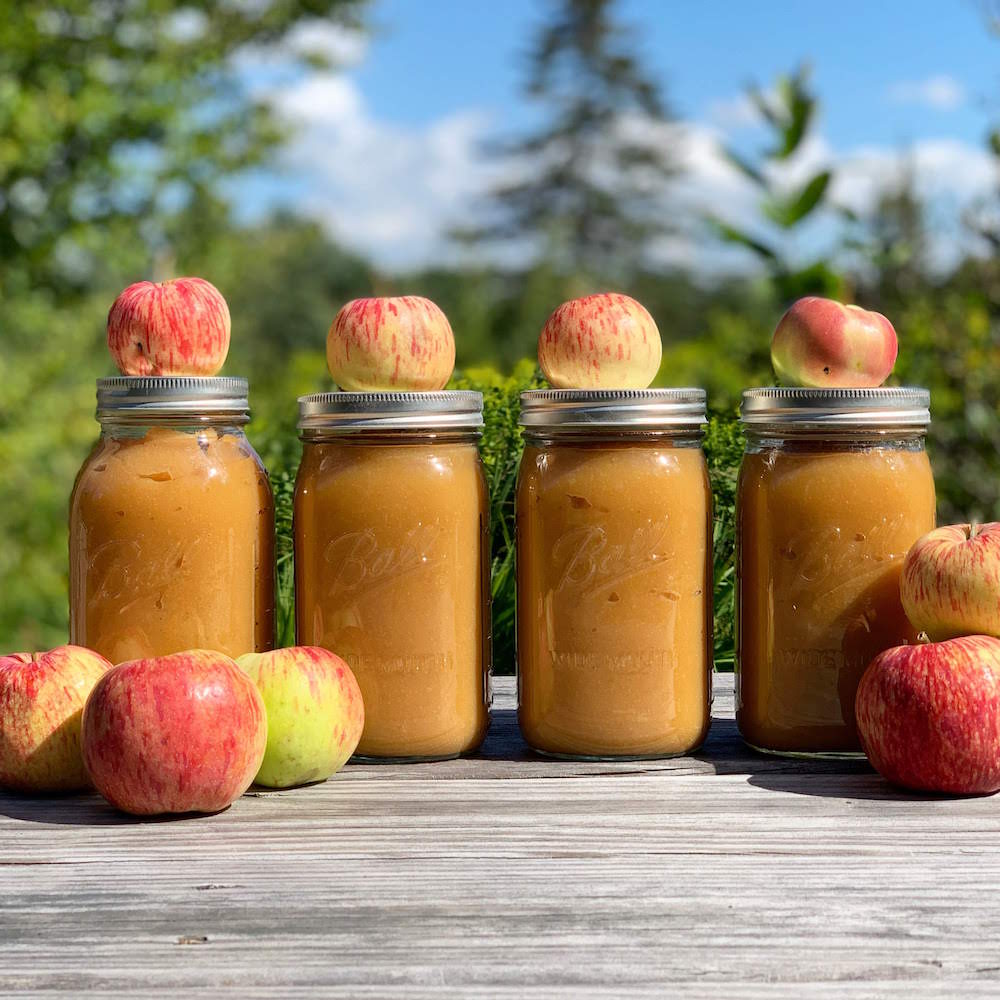
We’ve made other stuff from our gardens over the years–including kimchi, dried tomatoes, and currant cordial–but the above is the stuff we consistently eat and make. The kimchi, dried tomatoes and currant cordial all tasted kinda weird… so, live and learn!
I also want to be crystal clear that all of this would be cheaper if I bought it from a store.
Chickens have to be fed and cared for, garden seeds have to be purchased and planted and maintained, and canning is a real pain. I do these things because I enjoy them, certainly not because they save money. Potentially this could save me money over the VERY long term. Like if I’m still using the same canning jars and chicken coop in 40 years maybe I’ll break even. Not a joke, folks, not a joke. So don’t fret if you don’t have the time or space to garden or chicken–you’re not missing out on some major money-saving cabal.
Our Meal Plan
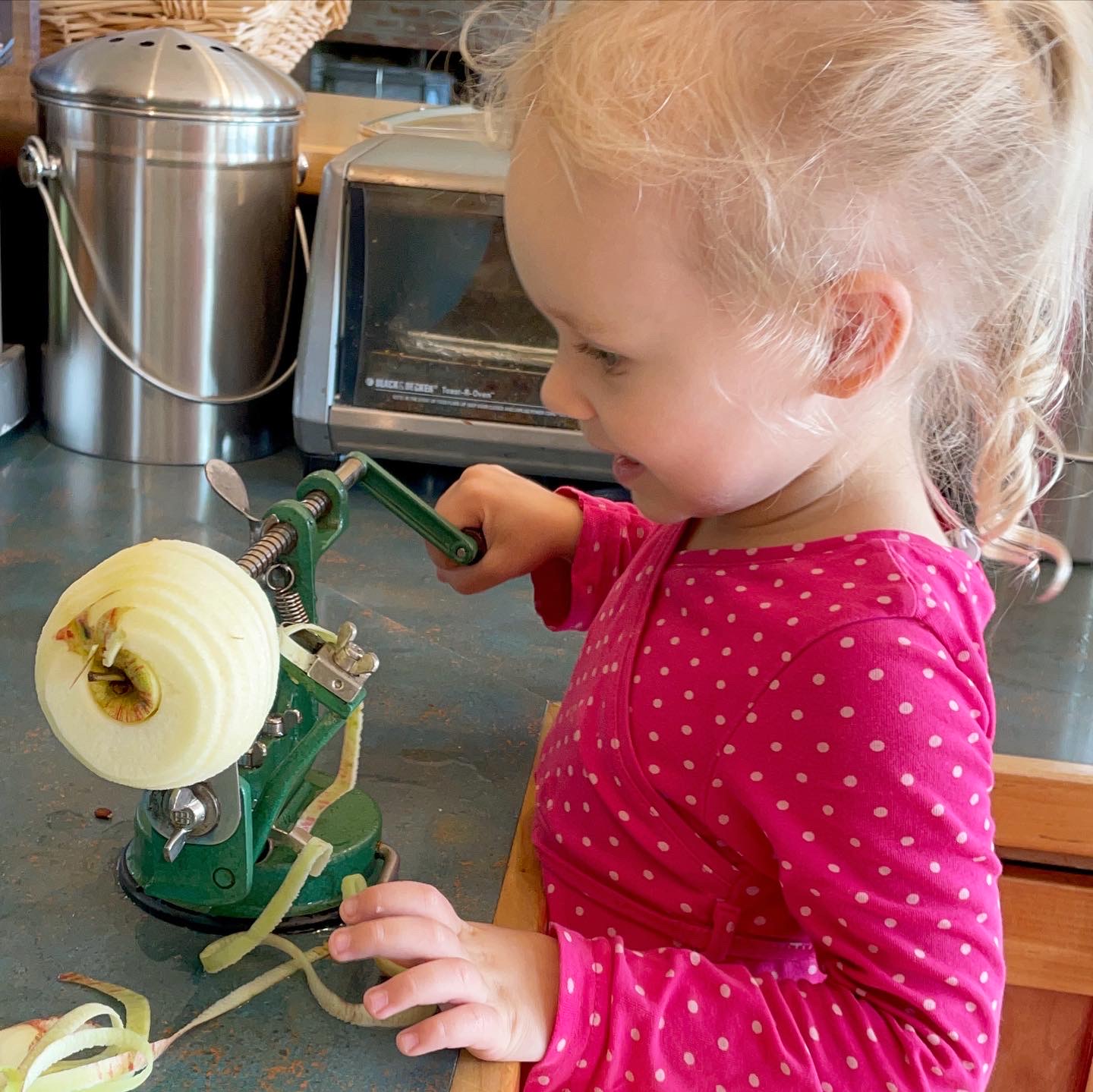
And here’s how we eat those foods. We are kind of boring in that we have a pretty standard rotation of foods. But we like it that way.
I am uninterested in spending a lot of time on meal planning and cooking; thus, I’m very content with a simple rotation.
I’d rather have more time and less variety, which works for me, but might not work for you! The key with food–and all things–is to figure out what works for you and what you’ll be able to stick with.
Breakfast:
- Organic rolled oats with cinnamon and a banana
- This is the same for all four of us every single day
- Seasonally, we include berries from our yard
Lunch (Liz):
-
Eggs from our chickens Scrambled eggs (from our chickens) and toast (from our homemade bread)
- I eat the same thing every day. I am a very boring person.
Lunch (Nate):
- Cheese on toast (from our homemade bread) and an apple
- He is also a boring person who eats the same thing every day.
Adult snacks options:
- Fruit, veggies, smoothies with plain Greek yogurt & frozen berries + kale from BJ’s, almonds, homemade hummus (using the bulk garbanzo beans from the Coop), cheese.
Kids’ food packed for school:
-
In case you’re wondering, Littlewoods 100% dropped this egg onto the floor Snack example: carrot sticks, apple slices, goldfish crackers/veggie straws/cauliflower chips (bought in bulk packages from BJ’s)
- Lunch example: PB&J (homemade bread, homemade currant jam, organic PB from BJ’s), grapes, cucumber slices
- They don’t get exactly this every day–it rotates based on what fresh fruit and vegetables are in the house:
- When we’ve eaten all the fresh stuff, they get things like: raisins, dried cranberries, nuts, etc. Then, we know it’s time to go grocery shopping.
- Sometimes I pack lunch meat and cheese sandwiches OR peanut butter and banana sandwiches OR leftover dinner items.
After school:
-
Kidwoods + our ripe blueberries The kids have their “treat of the day,” which is usually something gross like a ring pop from their Halloween/Valentine’s/Easter candy bags.
- If we have cookies, they’re homemade. I sometimes bake like 5 batches of cookies and freeze them. I find this very annoying to do, however, so I don’t do it often.
Afternoon Snack:
- The kids get whatever’s leftover in their lunch boxes plus–depending on how hungry they are–carrots, snap peas, cheese, homemade apple sauce, almonds, toast, plain Greek yogurt, etc.
- We have apples, bananas and oranges on the counter that the kids are always welcome to free-snack on:
- Consequently, I find apple cores, orange peels and bits of banana all over my house.
- Recently found a desiccated carrot behind our piano… Kids are great.
Kids’ Dinner:
-
Littlewoods planting tomatoes! Random leftovers:
- Last night it was whole wheat pasta, ham (taken out of the freezer from the ham we cooked at Christmas), snap peas and banana slices.
- Other common kid dinner items:
- Salmon burgers (purchased frozen from BJ’s)
- Quinoa or brown rice (served with salt and olive oil)
- Roasted sweet potatoes (or other roasted veggie: carrots, cauliflower, etc)
- Leftover homemade pizza
- Whatever fresh fruit/veggie is available
Adult Dinner:
-
Kidwoods harvesting tomatoes into her pockets… A salad with a protein, typically either: garbanzo beans OR roast chicken OR tofu OR salmon. We rotate between three basic salads every night:
-
- Asian-inspired: greens, chopped red cabbage, shredded carrots, sesame seeds, green onions, protein (tofu, chicken or salmon) and Asian salad dressing.
- I’d say this is probably the yummiest of the three, but it also takes the longest to make on account of chopping up all the ingredients and making the dressing.
- Here’s Nate’s recipe for this dressing:
- Minced fresh ginger, minced fresh garlic, lime zest, lime juice, soy sauce, fish sauce, rice wine vinegar, mirin, toasted sesame oil, red miso, and gochujang.
- Combine ingredients and blend until smooth.
-
The littlest currant picker Cranberry & walnut: greens, cranberries, walnuts, goat cheese, roast chicken OR salmon, balsamic vinegar.
- This one is BY FAR the fastest and easiest. It takes ~3 minutes to make.
- Nate will roast/smoke a chicken once a week and slice it up. Then, I dump the ingredients together right before dinner.
- The dressing for this is just straight balsamic vinegar, which adds to how quick and easy it is to make.
- Greek-inspired: greens, garbanzo beans, feta cheese, cucumbers, green onions, white wine & garlic vinaigrette.
- We prefer this one during summer months.
- The dressing for this is kinda made-up, by which I mean it is 100% different every time I make it, but basically… I whisk together olive oil, white wine, minced garlic, a drop of maple syrup, salt, pepper and red pepper flakes. It would make sense for me to write down the quantities, but eh, life is too short.
- Asian-inspired: greens, chopped red cabbage, shredded carrots, sesame seeds, green onions, protein (tofu, chicken or salmon) and Asian salad dressing.
Another typical dinner option (for kids and adults):
-
One of my all-time fave photos of Kidwoods (right after she picked ALL the carrots out of the garden… ) Roasted chicken and roasted Brussels sprouts (had this twice last week because we had a lot of both).
Saturday night special dinner options:
- Homemade pizza! Nate uses the following recipe to make his crusts:
- 454 grams water
- 12 grams sugar
- 25 grams olive oil
- 1 tblsp yeast
- 690 grams flour
- 1 tblsp salt
- Tacos!
- Spaghetti and homemade Bolognese sauce!
Weekly Bulk Cooking
All of our “core” cooking happens in bulk so that on a daily basis, I’m just throwing things together.
Nate is in charge of all core cooking, which includes preparing:
-
Carrot thief on the lamb Whole chickens
- Hummus
- Tofu
- Salad dressings
- Bread
- Homemade pizza
- Making jam over the summer
Daily Minimal Cooking
If I have time, I’ll do minimal daily cooking of things like:
- Roasted sweet potatoes
- Quinoa
- Rice
- Roasted Brussels sprouts
A Note On Kid Meals
Q: Liz, how do you get your kids to eat that stuff?
A: We follow the Ellyn Satter Institute Division of Responsibilities eating model.

When Kidwoods was about two years old (and Littlewoods was zero years old), we began to implement The Satter Division of Responsibility in Feeding protocol. That makes it sound super serious, but it’s a straightforward, simple framework for feeding kids that really resonated with us, made intuitive sense to our family, and that we continue doing to this day.
Here’s the rundown of the program, per their website:
Your [parent] jobs with feeding are to . . .
- Choose and prepare the food.
- Provide regular meals and snacks.
- Make eating times pleasant.
- Step-by-step, show your child by example how to behave at family mealtime.
- Be considerate of your child’s lack of food experience without catering to likes and dislikes.
- Not let your child have food or beverages (except for water) between meal and snack times.
- Let your child grow into the body that is right for him.
Part of your feeding job is to trust your child to . . .
- Eat.
- Eat the amount he needs.
- Learn to eat the food you enjoy.
- Grow predictably in the way that is right for him.
- Learn to behave well at mealtime.

As a result of following this approach, our kids are adventurous, eager eaters. Yes, they absolutely complain about some foods. Yes, they sometimes completely avoid eating a particular food on their plate. But, no, they have not starved and no, I do not deviate from Satter’s methodology. Does this approach work for every child? Of course not! Does this approach work for my kids? Yes.
I think the key for us is that we started when they were very young and have been 100% consistent. I find this approach SO MUCH EASIER than catering to specific likes/dislikes/complaints. My kids have preferences–which they’re free to voice–and I try to take those into consideration when preparing their meals. But, they do not dictate what or how our family eats.
How Do I Deal with Kid Complaints About Food?
The less said, the better.

Here’s a sample conversation from last week:
- Littlewoods (age 5): “I HATE Brussels sprouts! I WILL NOT eat them! UGGGHHHHHH! Ewwwwwwwwww!!!!”
- Me (age almost-39): “Ok.”
THAT’S IT. No need to engage, contradict, force or offer alternatives. If I force her to eat them, that’ll build resentment and potentially an unhealthy/bizarre relationship with food. If I contradict her and say, “you loved them the last time you ate them,” I’m just adding fuel to her preschool rage and she’ll see this as an invitation to dig in and fight harder. If I offered an alternative food, that would teach her that when she rudely whines about a food, she gets rewarded with a different food.
Conversely, if I am totally unbothered and either don’t respond or just say a breezy, “ok,” it diffuses the situation almost immediately. She still didn’t eat the sprouts, but it didn’t create a scene or a struggle. And for what it’s worth, she ate them the next night because she’d forgotten she hated them, in part because I hadn’t made an issue out of it.

If one of our kids declares they don’t want to eat ANYTHING on their plate, our response is also, “ok.” If they persist, our response is, “Then you must not be hungry. If you are hungry, that is the food you can choose to eat. It is up to you whether or not you eat it.”
I cannot remember a single time in the last seven years of parenting when a child didn’t eat at least some of their meal. Turns out? They’re usually hungry enough.
Do I Ever Force My Kids to Eat Something or “Try One Bite”?
Nope. Per the Satter model, it’s up to my kids what and how much they choose to eat of the foods I provide to them. I’m not in their bodies and I don’t know how hungry or full they are. Most importantly, I want them to develop their own satiety cues. If I constantly forced them to eat more or less, they wouldn’t develop the self-regulation that’s so crucial to how we nourish our bodies and enjoy food.

Regarding the “try just a bite” prompt, what do you think would happen if I’d forced Littlewoods–in her enraged state–to take a bite of sprout? She would’ve spit it out and screamed. It wouldn’t matter how delicious it was, she wanted to prove a point and BE IN CHARGE.
Once I realized that this type of prompt is about power–and has nothing to do with nutrition–it became a lot easier for me to disengage and diffuse.
Additionally, our wise pediatrician reminded us early on that children are physically incapable of starving themselves before the age of 7. In other words, if a neurotypical kid is hungry enough, they will eat what’s on their plate.
You, the parent, are in charge of buying and preparing foods. You, the parent, are responsible for determining the diet your family will eat. It is not the role of a child to demand, threaten or beg for certain foods.
DISCLAIMER: Of course there are a number of sensory disorders, neurodivergent experiences, disabilities, food allergies and other issues that make this an unsafe, impossible or even dangerous approach for some children and families. Again, I’m sharing this because it’s what works for us.
Do I Ever Let my Kids Eat Junk?

Absolutely. At birthday parties, cook-outs, Valentine’s Day parties, etc, they’re allowed to eat whatever’s on the menu: chips, hot dogs, cake, candy, soda, juice, etc. They understand that these are special occasion foods and I let them self-regulate (to a degree) how much of this food they eat.
There was a memorable experience when Kidwoods was 4 and she ate 4 hotdogs at a cookout and very nearly threw up… I will tell you that taught her A LOT about satiety and self-regulation.
On a daily basis, we let our kids have a “treat of the day,” which can be whatever they want and isn’t linked to a meal. Treats are consumed after school during our family “tea time” when we sit down and share about our days.

The girls can pick a piece of candy from their Halloween/Valentine’s/Easter/Birthday Party bags, a homemade baked good (if we have any), a cup of hot cocoa with marshmallows, or something like toast with maple syrup on top.
I like having “treat time” divorced from meals because it obviates the “you need to eat your healthy food first” conversation that can surround after-meal desserts. Again, I don’t force my kids to “just take one more bite” or “stop eating” or “try this please.” Having the treat exist on its own–and not as a “reward” for eating–seems to work well for us.
What We Spent in 2022
Alrighty, what you’ve been waiting for… here’s the breakdown of how much we spent on food during each month of 2022:
| Month | Groceries from Grocery Store | Bulk Foods & Farmer Neighbor-sourced Foods | Bulk & Farmer Neighbor-sourced Items Purchased |
| January | $868.73 | ||
| February | $770.08 | $172.54 | 50 lbs of organic oats
50 lbs of organic white whole wheat flour |
| March | $1,006.60 | ||
| April | $899.65 | $160.10 | 50lbs of organic oats
25lbs of dry organic chickpeas |
| May | $689.02 | ||
| June | $692.08 | ||
| July | $601 | $265 | 8 whole, frozen, free-range chickens (plus maple syrup and some misc. produce) |
| August | $630.56 | $50.00 | 8lbs of local organic, grass-fed beef |
| September | $636.70 | $83.29 | 50 lbs of organic oats |
| October | $673.97 | $8.57 | Yeast for bread |
| November | $810.64 | $110.12 | Thanksgiving turkey + maple syrup |
| December | $939.03 | $142.00 | 6 whole, frozen, free-range chickens |
| Subtotal Spent Per Category: | $9,218.06 | $991.62 | |
| Total Spent in 2022: | $10,209.68 | ||
| Average: | $850.81 per month | $212.70 per person per month |
Q: Liz, do you realize that a lot of people spend a lot less than you on groceries?
A: Yes, I do. As I noted, my goal is not to spend the absolute bare minimum on food. Rather, it’s to hit that central point on the Venn Diagram where frugal meets healthy (and delicious!).
How To Save Money On Groceries in 8 Easy-Peasy Steps
In closing, here’s the briefest possible list I could come up with:
-
Kidwoods making “dinner” with cucumber and currants Shop at inexpensive stores:
- Eliminate the Whole Foods and fancy Co-ops of the world from your routine.
- Buy bulk, raw ingredients:
- Always aim for the base-level ingredient.
- You want bread? Buy flour. You want carrot sticks? Get whole carrots. You want hummus? Buy dry garbanzo beans.
- Be selective about organic products and locate generic organic options.
- Limit meat and fish consumption.
- Always shop from a list. Do not try to wing it in the store.
- Be brutally honest about what, and how much, your family will eat.
- Nobody cares what you eat. Do what works for YOU.
- Devise a simple rotation of meals that you can easily, repeatedly execute.
- Do not waste food. Eat it up or freeze it.
- Avoid packaged and heavily processed foods (see #2):
- When you do need packaged foods, get them in bulk, i.e. giant bags of raisins from BJ’s as opposed to small, individually packaged boxes.
Create Frugal Food Habits
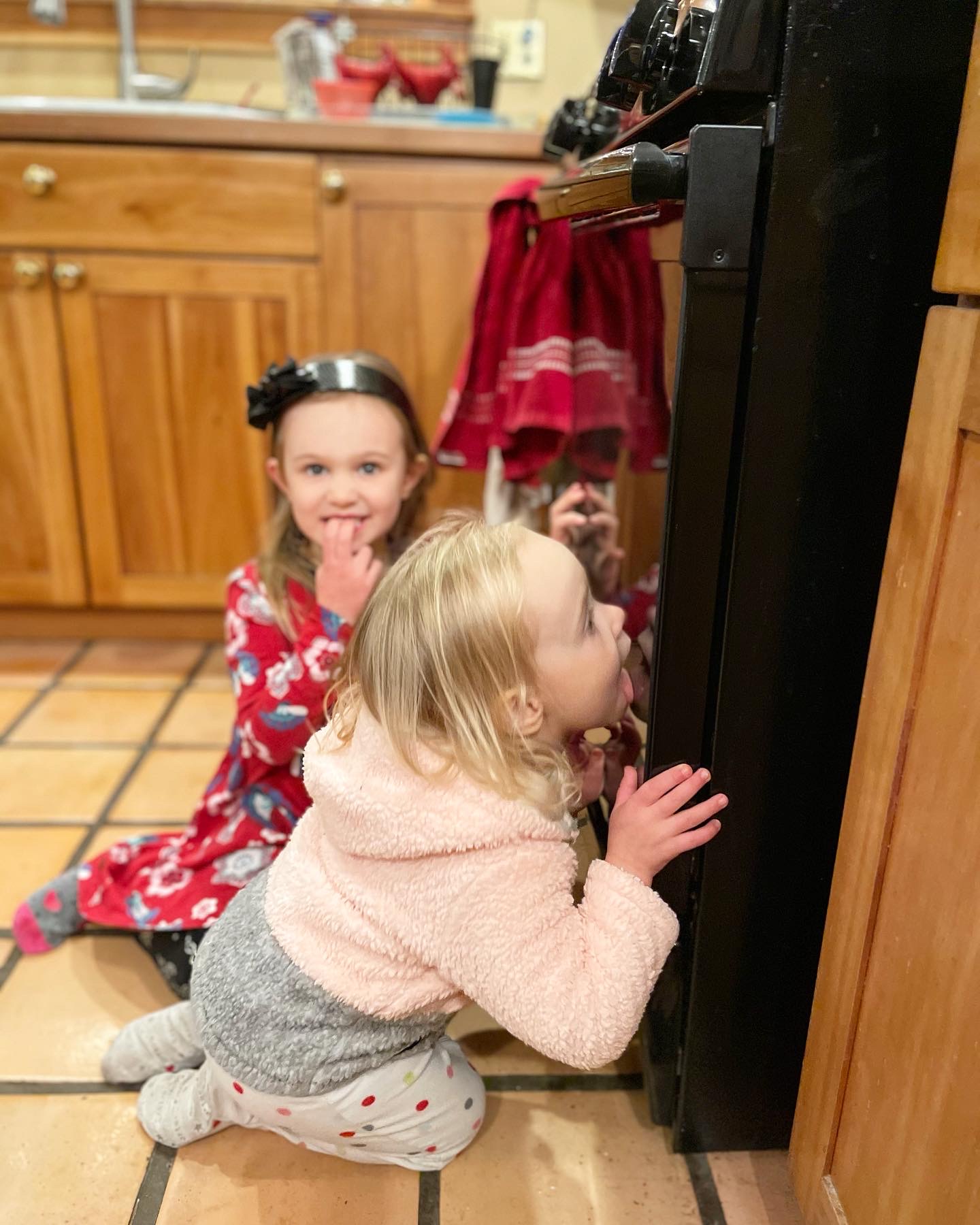
All of this is about creating routines and habits. Once you’re in this groove, it’ll be easy to iterate on. Yes, it’s a slightly painful learning curve at first, but once you go frugal, you rarely ever go back.
Take, for example, how we bake our own bread in our yard sale bread machine. Was it a learning curve at first? Obviously yes. Does it now take me 2 minutes to prepare? Also yes. Will I ever go back to buying expensive whole wheat organic bread from the store? Never ever.
Now that I know how to make organic whole wheat bread at home in 2 minutes for super cheap, why would I ever revert to my previously expensive ways? It’s cheaper, healthier, tastes better, engages my kids in cooking and makes my house smell AMAZING. The trick is to start these habits, engrain them into your routine and then keep on keeping on.


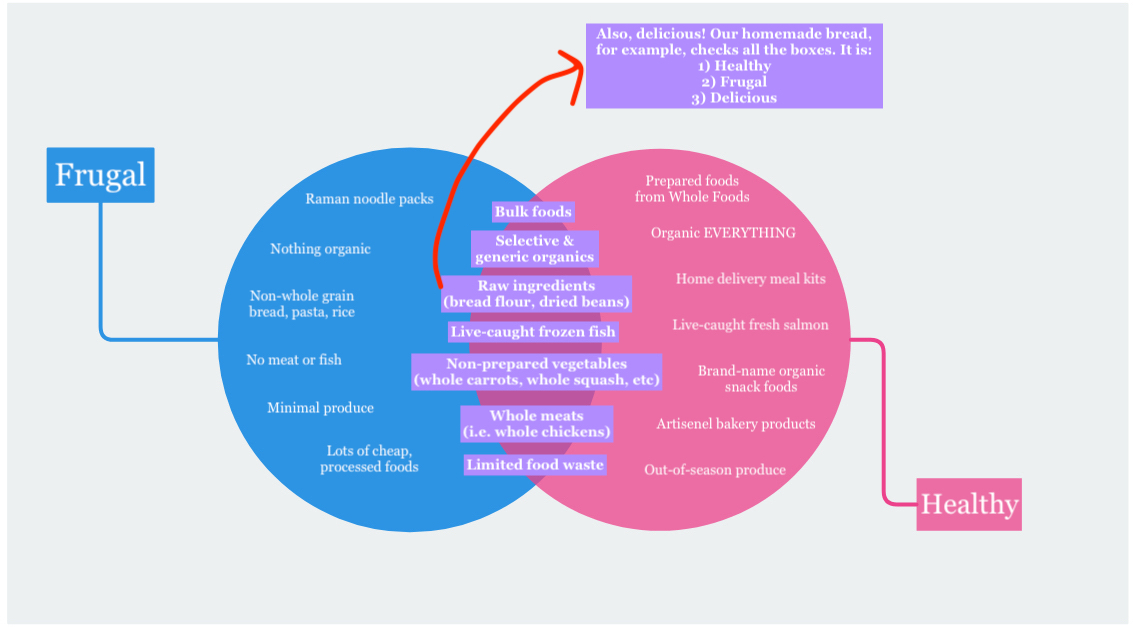
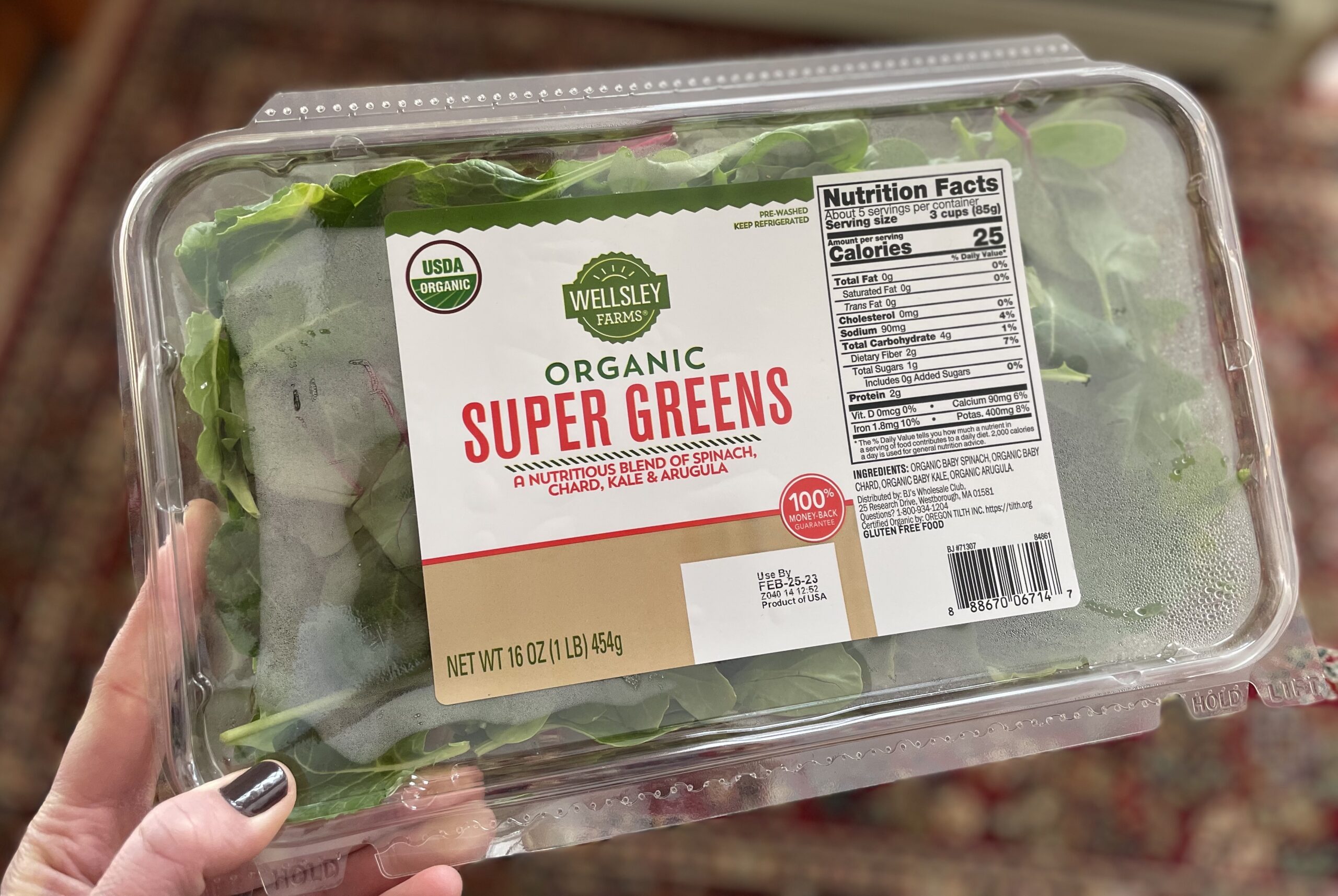












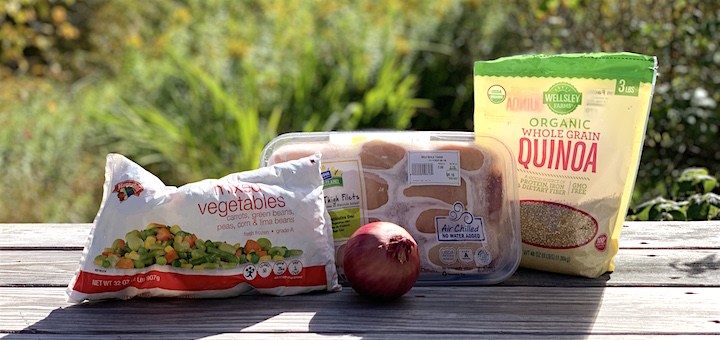
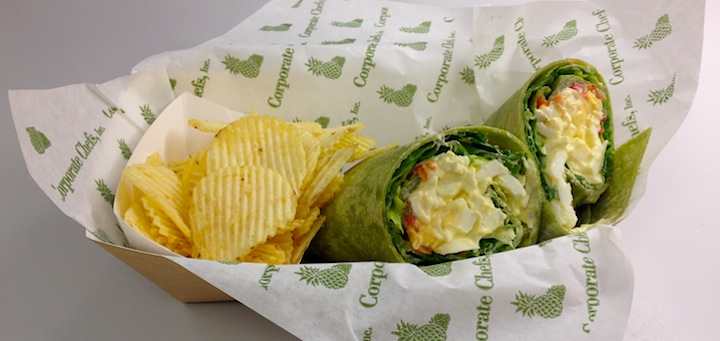
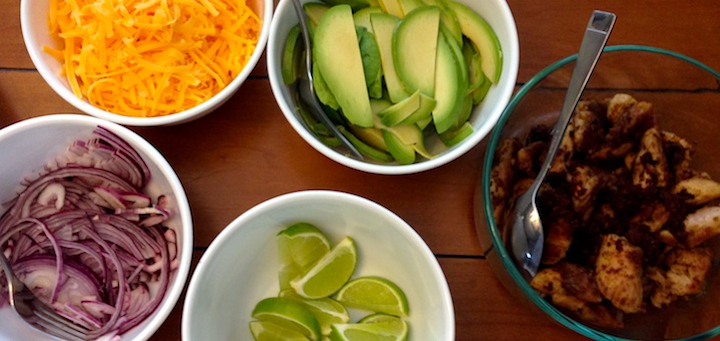


Thank you so much for your HONEST overview!
I really like that you are doing a mix of healthy and frugal options and not just focusing on price per se. It is important not to forget the love of and for food.
Hopefully one day when I have kids of my own, I can follow the Ellyn Satter Institute Division of Responsibilities eating model one day when I have kids 🙂
Greetings from Munich
Christina
PS: I recently bought your book and I am just loving it!I have already read it twice and it always motivates me!
PPS: This is my very first comment on a blog ever!
I don’t know. I spent $200/Canadian a week for a family of six including 2 teen boys. I find this kind of pricey. We eat a lot of chicken, eggs, apples, oranges, carrots, rice, beans, canned tomatoes, frozen veg, etc etc etc. The best is to buy what’s on sale and meal plan around that. I am now emptying my pantry and deep freezer, so I’m spending $100/Canadian a week for my family of 6. We are maybe half through the food since the start of the year. I don’t grow anything because I live in a townhouse. So that’s $7680 a year for a family of six (2 adults, 2 teen boys, 8 yo, 5yo). We only eat junk on movie night, when we make pizza and eat popcorn and maybe chocolate or a candy.
Thanks for this. This was an interesting read. I disagree about Whole Foods. Their sales are really good. Plus they are the closest to me.
We basically only grocery shop at Publix. They also have great sales. I used to play the multiple stops game, but the “savings” (especially at the expense of time and gas) weren’t worth it.
They are building a Whole Foods close to us, and I am looking forward to when it opens. (If for no other reason than maybe it will be easier to park in the Publix lot…!)
I agree with Julie about whole foods. They can often be cheaper than other grocery stores like Kroger, and if you have an Amazon credit card and a prime account you save even more.
Great post though – very insightful and informative.
Agree regarding sales at Whole Foods! I think some folks are still in the mindset of “whole foods, whole paycheck” but haven’t actually been there in years! Recently I bought some chicken sausage on sale at WF – came to under $3 per package. I have sometimes found their produce for less than what I would pay across the street at Aldi, not all items, but definitely sale ones. Also for “specialty” health foods which are their bread-and-butter they often have more choices than I would find at a “regular” grocery store, for example I can regularly find generic tofu at Whole Foods, but my local “regular” grocery stores (Big Y and Stop & Shop) only sell name brand tofu which is pricier.
I agree. Whole Foods’ store brand is comparable to every other grocery store near me, as are their sales. It really pays to shop around.
May I suggest making your own yogurt? Simple, delicious and waaay less expensive. If you’re a home canner you already have the skills and probably enough jars. Thanks for your honest take on food spending.
This! I bought a greek yogurt maker several years ago and it has paid for itself many, many times over. I do recommend going that method rather than the “yogurt maker with tiny jars” version or any of the hacks for doing without a dedicated appliance, only because it is SO easy to make with one. It takes about 10 min to heat and cool the milk + starter (which is just a couple spoonfuls of a type of yogurt you like – we use Green Mountain Creamery plain greek), then you pour it in the yogurt maker and it does its thing for about 8 hours. When it is set and ready, you pour it into a special strainer (this is what makes the appliance better than other methods – no having to use cheesecloth or something similar for the straining, so the cleanup is minimal), let that strain overnight in the fridge, and voila! Greek yogurt. It costs roughly half what a similar sized container would from the store. I find I do need “fresh” starter after several batches – you can use your own yogurt to start new batches but for whatever reason it loses potency over time. If you eat a lot of yogurt though it is an easy way to save some significant $$.
Even easier is an instant pot! Heat the milk to 180, cool to 110, add a few tbsp of the yogurt culture and set the instant pot to the yogurt setting for 3-4 hours. Refrigerate and poof, it’s yogurt! I make one gallon of yogurt every single week, going on 9 years! I’ve never had to refresh my starter (which is just a scoop of last weeks yogurt).
Ok, ok, now I’m intrigued!! We do have an instant pot…
If you have an instapot you should definitely try yogurt making. It took me a couple of tries before I got the hang of it, but once I did – totally awesome. 1 gallon of milk every 2-3 weeks, none of the annoying plastic containers that can’t be recycled…seventh heaven. I found a relatively easy recipe on the internet and that was that!
Oh definitely try it. I find I get a firmer yogurt using powdered culture (amazon) instead of some of the last batch. This may be a function of my milk or starter culture. Your mileage may vary:)
Yogurt is hella easy with the instant pot! I made it without it for years and it’s not *hard* exactly, but the Instant Pot makes it just *chef’s kiss* easy. And it’s good. We eat it plain, or with a little honey, or in smoothies. Look up a yogurt strainer on Amazon- life-changing if you like Greek yogurt. I used to use cheese cloth and it was such a pain. Now I have the Hatrigo 2-Quart yogurt strainer and it’s so much easier.
Absolutely worth using the IP for yogurt. My favorite method for straining for Greek yogurt is to use a flour sack towel inside a large colander, since I make a gallon at a time. It is way easier to rinse and wash a flour sack towel than cheese cloth.
I recommend a yogurt strainer if you like it thicker. It’s super easy!
The cold start method in the Instant Pot is even easier, but you do have to use ultrapasturized milk (I use Fairlife). Put milk in pot, add in a couple of tablespoons of your favorite yogurt and whisk well. (If you like it lightly sweetened, add one can sweetened evaporated milk also.) Press the yogurt button and let it culture at least 8 hours or up to 24 hours. The longer it cultures, the more probiotics. I usually do mine overnight. It comes out as thick as Greek yogurt with no straining necessary. I save some of each batch to use as a starter for the next one (I freeze it) and have been able to keep it going for months.
Yes, yogurt! If you don’t mind soy yogurt, you can make it even cheaper than using dairy. I make my own soy milk, which is super easy (and dirt cheap — just soy beans and water), and then I use that to make yogurt in my Instant Pot. You can adjust the thickness of your milk (beans:water ratio) to make thicker or thinner yogurt, so there’s no need to strain it to thicken it. When it’s done, you can add a sweetener or fruit or vanilla or whatever you want. It keeps for up to 2 weeks in the fridge, and you can freeze it to use in baking/cooking.
I’m intrigued by this. We’ve made regular yogurt for my family but I somehow thought nondairy yogurt for my lactose intolerant self would be harder.
I make mine in the dehydrator! Before I had that, I heated cotton sacks of rice and set them and the mixed milk/yogurt into a cooler and let it sit overnight. It worked. I use plain purchased yogurt as a starter. I can use my own yogurt as a starter too, but it seems to need “refreshing” with purchased yogurt after a while in order to get good and firm.
We also have just left it in the over with the oven light on (not turned on)
Yes to yoghurt! And you do not need a yoghurt maker. My yoghurt making equipment is a pot, dollar store meat thermometer, mason jars, funnel and small cooler (for incubating). I do occasionally buy REALLY good yoghurt to get fresh starter cultures. In contrast to what some people wrote, I had the best success with organic pasteurized and homogenized whole milk. The ultrapasteurized milk produced either thin yoghurt or too much whey. Also, you can buy probiotics capsules in the supplement section of most supermarkets, I had success using those when I did not have any yoghurt. Another tip is that a mesh colander and a flat bottom coffee filter make a good strainer.
I agree that your diet is decent, and organics do cost much more, however, if you read “The Obesity Code” you will learn that eating too many times per day is not healthy, no matter what age you are.
If you deleted the animal foods except for eggs and cheese, it would also reduce your expenses and improve your health.
Adding some walnuts to your morning oats would replace the animal protein with more omega-3s and fiber.
I didn’t get the impression she was looking for advice, and based on appearances alone ( which is no measure of health) obesity is not a concern in their home.
“The Obesity Code” by Dr. Jason Fung is a great book, and you don’t have to be obese to appreciate its lessons. I’ve never been obese, but did appreciate his advice to lose ~10-20 lbs I was holding onto. Another great book is “Fast Feast Repeat” by Gin Stephens. Both recommend Intermittent Fasting, which I was going to post about being a good “frugal hack”, and at least a time saver. Skipping a meal per day, as well as skipping snacks saves money, time, and is super healthy *for adults* (kids should still eat more often since they are small and growing) despite what our culture has purveyed since the 1970s. Eating 3 meals + 2 snacks per day raises our insulin levels, keeps them up all day, leading to insulin resistance, destroys natural satiety cues, and is a reason western society has become over weight in the last several decades. Fasting is very healthy for people of all sizes (except those who are too thin).
I would gently suggest that we let other people do what works for them. I say this as someone who works with folks with eating disorders – what works for you could be the beginning of a relapse into illness for someone else.
Yes. This. Don’t give unsolicited diet advice.
Also just chiming in to say “yes” to this post and to the Satter Division of Responsibility method.
❤️
What animal protein at breakfast are you referring to replacing? I don’t see any.
I find that following one book’s advice on any specific topic is often a dicey idea, particularly one that’s very prescriptive and suggests removing entire categories of food.
Also, I feel like the family weren’t looking for dietary advice as such.
Curious to know how the girls school handles meal times? Ours unfortunately encouraged the “just one bite” method and I’m not sure what to do about it!
As they’ve gotten older, there is less conversation about the food at school, which I really appreciate. In general, I think we as parents can reinforce our beliefs at home and then it’s ok to have something different at school. But it is really frustrating when you’re seeing something that contradicts what you’re doing at home.
Thanks for this blog – particularly the bit about feeding children. I have a 17 month old and weaned him “by the book” and now we’re entering into the start of the fussy stage so I needed the reminder to just relax and let it go. Two weeks ago for instance he just wouldn’t eat dinner, the following week I couldn’t fill him! Going to look up that model of eating now.
Sending you strength! That’s such a tough age! I always kept my pediatrician’s reminder in my head that “they cannot starve themselves–if they are hungry, they will eat!” I still see that swing back and forth in appetite–some days they have third helpings, other days they barely touch their food. I really appreciate the Satter Institute methodologies–I hope they’re helpful to you! Good luck!
My pediatrician also told me to look at a full week, not just one meal or one day. That helps me a lot too!
Liz, I appreciate that you stated in the post that neurotypical kids won’t starve themselves, atypical ones are quite capable of coming close to it.
I love your (ot the) approach of feeding the kids. It is what I aspire to as well, but with a few tweaks due to my kid being neurodivergent.
Thank you for putting a disclaimer regarding neurodivergent children btw.
You are most welcome! I always want to acknowledge that what works for me and my kids won’t work for everyone. Same goes for adults–we all have to forge our own path 🙂
Just a note- I periodically try Aldis but keep returning to Whole Foods. At each I buy a weeks worth of groceries for about $65 but better quality food at Whole Foods, if you stick to simple foods and store brands.
That is good to know!!! I kinda use “Whole Foods” as a stand-in for expensive grocery stores, but maybe I’m unfairly maligning them :)!
I had never thought of the “just one bite” exchange being about power, but now it seems so obvious. I have a food-phobic (now-adult) family member who, even now, gets coaxed/challenged to try one bite. He never has, never will, and it’s a power-play to keep trying. And disrespectful. I’ll never “encourage” him again, and I’ll try to move it on, if someone else does.
Yeah, it was a huge revelation to me too–it’s totally about power! Kids have such limited opportunities to exert power that mealtimes can become a battle if the parent chooses to engage.
I truly appreciate your thoughtful approach to meal time. I came from a “clean your plate or else” parent. I became anorexic. A therapist asked me ,”Why do you suppose your locus of power was focused in how you ate?” Immediately our unpleasant meal times came to my mind…later I would explain that I was just trying to own myself…giving children dignity and power to own thier own bodies via deciding whether they will eat the food option offered would have prevented so much suffering for myself and others.
Yes, and who is to say if they are hungry or not. As Liz stated, she is not in their bodies. She can’t be the one to determine if they want to eat or if they don’t feel like eating. We, as adults, have days we are not hungry and days we may eat more because we are hungrier. I was raised with clean your plate, if you didn’t like what was served for dinner, you went hungry. I also attended catholic school in the 60’s. The nuns would patrol the cafeteria to make sure everything was eaten! One day, a boy sitting next to me, was told to finish the rest of his food. He was crying that his Mom always packed him too much food and he couldn’t eat it all. Well, he ate the straw paper as well. That’s how intimated the nuns were back in the day. Anyway, this young man was obese at age 9. And they were forcing him to eat! I struggled most of my life with being overweight. Gee, I wonder if had anything to do with being taken to a Dr at age 12 (in the mist of (puberty) and being put on a 1200 a day calorie diet. Our bodies know when they need to eat and what they need to eat. I like Liz’s philosophy of how she eliminates meal struggles. I wish I had known these tricks when I was raising young humans. I will recommend the book she referenced when and if my girls have children. Great read, thanks Liz.
I want to second the thank you for the neurodivergence caveat. I understand that most advice has to cater to the masses, but as the parent of a child who did repeatedly attempt starvation, the societal and medical gaslighting on this subject is surreal. I’d like to point out that kids who try to starve themselves often do it before they are old enough to get a diagnosis. So if your kid doesn’t seem to eat enough and is screaming continuously 8+ hours every day, you’re not crazy. You deserve help and support, not a brush off.
I also want to praise Liz for being willing to share her personal food situation. To do so is always to invite heaps of ludicrous advice, which is tiresome. I’m glad you have a system that works for you.
Neurodivergence can really make eating / food such a tricky thing. My eldest is on the spectrum – he’s now nearly 17 – and though he definitely has his various struggles, one thing we have never had to deal with is eating / sensory / ARFID issues, and for that I am profoundly grateful. I know it’s quite a bit of luck involved, and I can’t imagine how difficult it must be where eating is a battle.
What does always strike me as curious though is people who are very clear that their kid has sensory eating issues BUT who refuses, point blank, to seek an official diagnosis of any kind, be it for autism or anything else, because ”I won’t drug my child”. I mean, these things rarely exist in a vacuum. There are often other things that go with it, but the dissonance is real.
Thanks so much for this detailed breakdown! After rent and childcare, groceries are by far one of our biggest expenses and I’m always looking for realistic ways to decrease what we spend there while still maintaining our health goals.
I also appreciate the acknowledgement that this is what works for you and your family, and it may not work for others – of course we all have different opportunities and different limitations. I can’t eat gluten (so cheap noodles and bread are out, whomp) and my 2-year-old is in that extra picky phase, plus we incorporate more pricey foods that help address specific chronic health issues that various family members deal with. These are our limitations, but even with these challenges there are so many ways I’ve found I can drive down grocery costs when I want/need to.
Just one thing I’ll nitpick on:
“I cannot combat systemic economic disparities, much as I would like to.”
Actually, we can all combat systemic economic disparities! Just not by altering our personal grocery shopping habits. But we can vote for politicians that speak to the importance of economic equity, we can call our elected officials and ask them to support new policies that would support families who don’t have the same economic resources we do, we can work in our local communities to provide supports for economically stressed families – and much, much more. I know you know that, and I don’t think you were trying to literally say that we can’t have any impact at all on economic inequality, but the way that sentence was phrased could be misleading to newer readers.
Oh, and one last recommendation: I love the Instagram account Kids Eat in Color, which talks about feeding kids (dealing with picky eating, division of responsibility) but also addresses policy issues around food, like changes to the WIC program. They also have an online recipe program called Affordable Flavors that provides a month-long meal plan full of frugal foods (they say under $550/mo, though that was pre-inflation). You can pay for the book if you’re able to do so, but you can also apply to get it for free if you have economic need. It’s a great resource for anyone here who wants other ideas for eating frugally, especially those who might have different cultural foods (which they incorporate) or eating preferences.
Thank you so much for this thoughtful comment! I really appreciate your insights and recommendations
I love Kids Eat in Color! It’s been a helpful resource for us too.
I think the point of the statement has been missed *a little*. Liz is giving a break down of how they eat and what they spend on their food. She was noting that she, singlehandedly, is not entering into a political debate about how she could be doing more and how to vote and shame, shame, shame on her for (insert whatever privilege) she happens to currently have. I feel like she might have been trying to avoid, you know, getting lectured on same, as well as given notes on writing style, but… oh well…
Agree. She’s not going to solve systemic problems in one blog post…. or ever. I do always appreciate reading/learning things, though, that I didn’t know about. Even though my kids are grown, I’m going to look up Kids Eat in Color.
I really admire how the Frugalwoods family functions and how the parents make decisions.
Family meal times can be so fraught.
My goodness, if a simple comment saying “oh hey, actually we can have a big difference on this common social problem” feels shaming to you, that really sounds like a personal problem you might want to spend some time working on.
I love Ms. Frugalwoods because her writing is more socially conscious than most FIRE blogs and she’s mentioned being community oriented in the past. I think a dialogue about how that fits with how we think about food and economic equity is right up the alley of this blog. If you don’t agree, feel free to skip on past this particular internet stranger’s comment.
This is really refreshing and validating. So many in the FIRE / frugal community brag about feeding their 4-member families with $200 per month. Look closely and you’ll see they achieve this by eating a bowl of cereal or a PB&J for dinner 3 times a week. Good for them but I don’t consider that eating “well”. You post is very aligned with our family’s habits and values. Thanks for sharing!
Thank you! Yeah, we really prioritize eating “well,” which I know is totally subjective, but it works for us. I know we could spend a lot less on our groceries, but the fresh produce is a huge priority for us.
This is so interesting and helpful to have a full breakdown! Great, you eat so many fresh fruits and veggies!
One question for the adults though – does it feel like you are eating enough? Especially with how active you are on your homestead?
(I ask from personal and work experience)
From what you wrote it seems like it would be very hard to get the 2,000 – 2, 600 calories active adults need in a day!
This is inspiring! I love recipes and cookbooks, so the idea of eating the same thing every day(ish) is depressing, but oh how I wish I could embrace it like you do because it’s clearly way more simple and frugal, and would llikely cut down on our food waste. Also I would probably be healthier– a salad every day!? Imagine.
What you said about being brutally honest about what your family will eat really struck a chord with me. I’m pretty bad about buying lovely greens at the farmers market and then letting them rot in the crisper drawer. For shame! We do compost everything, so I don’t have to feel guilty about landfilling food, but STILL.
I’m going to try a modified version of your plan and find 4-5 meals to make every week for a month and see how that feels.
I do like to embrace batch cooking. My family has a favorite, delicious, black bean soup that we love, and it makes a ton (uses 3 lbs of dried beans) and so we freeze it for the future. Future me is always SO thankful.
Oh– one other frugal tip I have is: Dumpster Diving. I don’t actually get in dumpsters or anyting, and I don’t touch anything gross or smelly, but you would be surprised (or maybe not!) at the amount of food that is tossed by grocery stores. The biggest chain in our area has a trash compactor, so I have no idea what they discard, but the smaller stores have regular old bins outside and I check the one closest to my office most days on my way home from work. Things I’ve grabbed (easily, on top, in-and-out within a minute or two) include: bunches of brown-spotted bananas, perfect for freezing for smoothies or bread, bags of organic bell peppers, lemons, limes, oranges, apples and pears, bags of potatoes and sweet potatoes, containers of berries –where most of the package is fine and one or two items have gotten spotted or soft, perfectly fine squash and pumpkins… It’s pretty amazing actually. And I’m in FL where it’s obviously not the best climate for this type of thing– I can only imagine what might be found still good in a cooler climate! I highly recommend trying this if you feel comfortable. It’s a pretty taboo subject, but I am an evangelist 🙂 Food waste is so upsetting!
I love the economics (and “eco-nomics”) of this idea! I would also caution people re: making sure that they are not getting food that has been in contact with rat poison. Stores will often put rat traps and bait near dumpsters, so if you go this route, please look to make sure that if you’re grabbing food that’s around the dumpster, double check that it’s not near traps or bait!
Regarding your first paragraph, what I’ve found works for me is to eat the same breakfast and lunch, with varying dinners, Monday-Friday. Then on the weekends I eat a more indulgent breakfast, maybe something different for lunch if I want, and again something different for dinner. I do eat leftovers for dinner, so I might have the same thing 3 days in a row, but I’m careful to choose foods I really love and look forward to eating. I do get a bit tired of my weekday breakfast by Friday, but it’s easier to just eat it than to come up with something different at 6am! I love recipes and cooking, too, but I was starting to feel like I was constantly cooking, and this really helps.
Hi Liz, I think you are doing a great job with your children (we follow the same philosophy and your food budget. Perhaps it’s different up there where you live, maybe more expensive than here in Boston.
My passion is almost every day cooking from scratch food from all over the world (it does not mean super fancy or expensive or time-consuming. It means healthy, vegetable and legume-centered food for which I have the right ingredients and condiments). We shop only at Whole Foods, farmer’s markets, farm stands, and occasionally Trader Joe’s, and we eat 75% organic. I buy only high-quality condiments (example: a $20 soy sauce fermented for 3 years, imported from Japan) or make my own. They last a long time, so it’s worth it. We spend about $500 a month for ingredients for our twice-daily home-cooked meals for 4, I must say that we do not eat any meat, but we do eat the best seafood available at Whole Foods, fancy organic and/or local cheeses, lots of fruits, and the occasional egg. In my experience with good planning and no waste, it is possible to eat organic or fancy for not too much money. But it does take very good planning. I also don’t spend more than 1 hour a day in the kitchen plus any time I’m fermenting or making my own condiments (or reading recipes). I basically have a system in place after doing this for 20 years.
Sounds delicious! Yeah, I was shocked at how much more expensive groceries are up here versus in Boston. Back when we lived in the city, we spent SO MUCH LESS on food. We loved Market Basket and Costco! No Market Basket or Costco up here sadly
I love how you eat so simply and delicious, but we just can’t do it around here because we love cooking and eating all kinds of food. We also don’t eat at restaurants or do take-outs to save money, so that boosts our budget for cooking ingredients. Market Basket is great, we buy some ethnic ingredients there, but their organic produce section is more expensive than at Whole Foods. A new store opened recently in Burlington (MA) called Mom’s Organic Store, and they are like an all-organic version of Trader Joe’s, and somewhat of an alternative to Whole Foods. Too bad you guys don’t have all these options there, but I still wouldn’t trade where you live for the city (I’ll probably have to drive down to Boston monthly to stock up on my favorite foods though). Beautiful family, beautiful children!
From informal reviews of friends and family, the “northern” states (VT, NH, ME) have very high COL even compared to Boston while the wages are much lower. Grocery stores in particular seem to be more expensive. Tourists, less competition, high expenses? Not sure the cause. Luckily NH and southern ME have some MB’s.
Could just be that stores in more inland states have to pay more to ship in food. Not something I know a ton about, but I live in Boston now and the food is so, so much cheaper than it was when I lived in Iowa. I’ve noticed more urban coastal areas have much cheaper grocery options.
Have you considered making a (large) batch of cookie dough in advance, but freezing the unbaked dough instead of baked cookies? I often find rotating cookie sheets in the oven, wrangling cooling racks, etc, to be the worst part of baking. But if you portion out the dough and freeze it on cookie sheets, you can move the frozen lumps of dough to a ziploc bag and then bake them off weeks/months later with basically no changes. I generally add a minute or two to the bake time, but that’s it.
If you want more fresh cookies in your life, that might be an easy to change to make it work for you!
I have done that in the past, but then I just find excuses to eat a lot of cookies… I have no interest in my kids’ gross candy, but I have A LOT of interest in baked goods I make 😉
Me too! I have banned myself from baking any more cookies, because I always used to make heaps of them and freeze some, but they never lasted very long. Whereas I find that if I buy a packet of cookies from the store, I know that they have to last the whole week, so I leave them for the kids to enjoy.
In Minneapolis, Trader Joe’s is the cheapest place to buy eggs.
Same here! I get quite bummed when I go there and the whole egg area is completely empty…
I love this! I will concur with your method of feeding your children. I raised my four boys the same way. I made the dinner I wanted, and if they didn’t like it, they didn’t eat. (I cooked pretty much the way you do, with the exception of the home-made bread.) I wasn’t about to get sucked into making special foods for each child! They’ve always been good eaters (not picky like some children I’ve seen), in the 90th+ percentile on the growth charts, and now that they’re teens and young adults they still eat eat practically everything.
Favorite story: We all ate dinner one night, then had ice cream. Then a young Boy was still hungry, so he ate the cooked gizzards from the chicken I had just made broth with! The adults at the table were horrified! (What a way to follow up your ice cream, ha ha!) Interestingly, this was my picky eater who still to this day says he doesn’t eat anything green.
P.S. Another funny story! (I so rarely get to share these, lol!) This is an Actual Quote by me to an Actual Boy at dinner one night: “You need to stop eating salad and eat your pizza.” 😀
Lol I too once said to my daughter “that’s enough watermelon, have some chips” because she would eat fruit to the point of sickness as a toddler.
Thank you for the salad recipes! Perfect timing, as we just decided to pivot our weekday dinners in this direction. Also appreciate the approximate quantities, as the chances of me measuring salad dressing ingredients is zero 🙂
Bahaha yeah, I just kinda throw the ingredients in a bowl and keep going until it tastes “right” 😉
This is all great advice! We aren’t actually that far off from your #’s with our family of 6 (one of whom is a 4 month old, so not eating table food yet, but as I’m breastfeeding, I eat more than a “standard” adult..) if you subtract out toiletries and household goods from our food purchases, but always looking for ways to save even more. We already do many of the things you suggested, but we do eat a lot of hummus (with homemade pitas – yum!!) and I’d neglected to think about whether making our own might be cheaper!
I did want to comment to say it actually is possible to save some significant $$ with homegrown produce, however there is definitely a huge time investment. We have a ~25×50 standard garden plot + five 4×8 raised beds (and apple trees and cherry bushes that will eventually produce, blueberry bushes that started producing next year, and a pre-existing giant wild blackberry patch that gives us gallons of berries every summer). By choosing the right things to grow, we spend about $300/year on supplies and harvest at least $1000 worth of produce, valued at grocery store prices not the true equivalent which would be from the local organic farmer’s market. We have a big chest freezer and freeze lots of corn, tomatoes, squash, diced green peppers, and cooked black beans, and we pickle & can some of the rest, plus very rarely have to buy anything for produce at the store between June and early Oct. We also grow long keeping varities of onions and garlic, and are able to go most of the winter on our own supplies of those – I’m always expanding the amount we plant so as to try to eventually be able to go year round with at least some of our homegrown produce! Last year I started drying our own herbs as an experiment, and that has proven quite worth the time and effort as well.
Obviously not everyone has the time, energy, desire, know-how, or land to do this (though our property is just barely over an acre, and the garden and food beds really don’t take up much of that space at all). I just didn’t want your readers to think that gardening is always a losing $ proposition! It doesn’t pay nearly as well as using the same time-energy at a job would, but if you enjoy it (as I do), it pays pretty well for a hobby, and I get great satifisfaction from knowing exactly where our food has been, what’s been applied to it, and the fact that it only has to be “shipped” from the backyard to the house 🙂
“Consequently, I find apple cores, orange peels and bits of banana all over my house.”
Made me laugh – this is my life 100%. (Kids are 17, 14, 11).
Just so. many. pieces. of. produce! The desiccated carrot really did me in 😉
Reminds me of the time I found a half-eaten grilled cheese in my lazy susan. Ahh, the memories….
Thanks for sharing this! As my kids have gotten older we have talked about how they don’t have to like or eat everything for dinner, but they do need to be respectful of my time and effort spent making it and not be rude. They can politely express that they don’t like a food for sure, but the “I hate this!” or “Why did you make this?!” is not polite (again they are older than yours! Definitely factors in). The other day I made a roasted squash, it was a softer sided one so you slice and roast. My son was not a fan but came up with….”I like the shape of the squash” lol.
BAHAHAH I love that! Yeah, we talk a lot about polite responses to unliked foods as well! My 7yo is pretty good about it, but the 5yo is still getting the hang of it…
Yes! I heard someone say once that she teaches kids that it might not be that they don’t like XYZ food altogether, but that they just haven’t had it prepared in a way that they like yet. Maybe they don’t like boiled chickpeas, but they’d like hummus or those crispy roasted chickpeas or whatever. Or maybe a different sauce on the chickpeas would make all the difference. Of course, we all have our preferences, but it’s nice to stay open-minded, especially when you’re still young and really haven’t had something prepared in a lot of different ways!
I was really fascinated with the Satter protocol and had not heard of it before now. I wish my grandchildren had been raised that way. We have a 16 year old grandson who will only eat chicken and steak as a result of his parents catering to what he wanted to eat, which is not how I raised my son. My parents followed a similar strategy to the Satter protocol, which was implemented as no one was asked what they wanted to eat, what was served is what you ate or you did not eat. No begging to try just one bite, no tolerance of complaints. If a child had a meltdown at the table they were excused to their room so everyone else could enjoy their meal.
However, I have very fond memories of the good food my mother prepared, and she would indulge requests (on occasion) for things that were in the regular rotation anyway. One of my favorites was cabbage and potatoes, sometimes with ham, sometimes not. I continue to make that to this day (and I have been cooking for almost 40 years). This was in my rotation so regularly that once my son (as a teenager) asked, “Mom, why do we eat like coal miners?” I thought that was hysterical. Yet he ate this meal on the regular without complaint.
I really enjoyed this post!
I’m impressed your son knew what coal miners might eat!
Many families have so many bad memories of dinnertime. I remember watching a cousin force-feed her young daughter corn. It was horrifying. I also remember friends’ kids who only ate mac and cheese or chicken nuggets. Yes, starting young with the Frugalwoods’ kind of good habits seems like the way to go.
I would love the hear how you do the cabbage and potatoes!
My mother was from Ireland and she used to make “colcannon” which is an Irish dish made from potatoes and cabbage. You can look up the recipe online.
Try growing your own garlic. Very easy. Just don’t use grocery garlic to plant.
Do you not include your beer and dining out in this? Is that along the lines of entertainment? I don’t really care, but it is food/drink so in my brain I’d add it to my total if we did those things. It does seem high to me but I don’t really care, it’s your family and your choice obviously. I spent about $6000 last year for my family of 6 in the US.
Good question! I didn’t include those totals here. This is just for groceries. Those totals can be found in my monthly expense reports where I include them as separate line items.
I put beer, wine and eating out in the entertainment budget. Sometimes I sneak ice cream and those expensive chocolate bars in there as well 😎. I feel this is more discretionary than food and easier to cut first when we need to have a extra frugal month.
When budgeting, I categorize dining out and beer wine as entertainment. I do this because it is a treat for us and we don’t do it often. It is not in my food budget.
Thank you for the neurodivergent/allergy/sensitivity disclaimer. My child is neurodivergent and there are a lot of typical kid friendly foods he just will not eat no matter how hungry he is (peanut butter, yogurt, raisins, etc). He’s also in the low end of weight for his age. The take it or leave it approach that works for a lot of typical kids is not right for him. A lot of people don’t get that and criticize.
I hate food waste! I freeze vegetable scraps from cooking and bones from a roasted chicken or turkey. When I have a good amount, I cook a big pot of stock for the freezer. It’s so much better than store bought. Lately, I have been following thecrosslegacy.com and while the prep takes a little time, it is so worth it. Produce lasts for weeks and it’s handy to have some things prepped for cooking.
I appreciated the acknowledgement that gardening and storing food is a hobby, not a way to save money. I also love to garden, but agree that you never really get a big ROI financially. It’s more about the satisfaction of growing something yourself, tastes better than the store bought stuff, etc.
I had my kids about 30 years ago and vowed not to do what my parents did. I’m still traumatized by the fights my mom and brother had over eating one pea!!
Never heard of the Slater Method but apparently followed it intuitively. My kids are healthy, fit and no food issues! Congrats and keep up the good work.
Although, I do support my local coop. They pay good wages and benefits and support local producers. I know everyone doesn’t have this option. But if you can afford it, please support your local coop, grocer and farmer.
I agree! One of my values related to the food budget is to support a locally owned grocery store while not going broke. I find that many of their prices are very acceptable. I refuse to shop at Walmart, so other than the local store I must travel 25 miles to a city for a Krogers store. The time and gas to do so add to the food cost in my mind, so I only buy things there that I can’t get at the local store. Small local groceries really struggle to get high quality produce, which is frustrating.
I have a church sale bread machine that I got for $4 about 20 years ago and it’s still going strong. I use it mainly to make dough but not to bake in. I tried baking in it and didn’t like how it turned out. The texture was off. Do you bake in yours too?
Hmmm, yeah I do bake in ours. I will say that I’ve adjusted the recipe over the years as I find that different bread machines respond differently to recipes. I include my recipe in this post if you’re interested. Good luck!
The hard hitting, deep diving, intriguing journalism we were all waiting with baited breath for. Bravo!
But seriously I’m sourcing bulk organic oats TWO-DAY.
BAHAHAHAH I do what I can 😉
One thing we do is use frozen vegetables frequently. You can get them very cheaply, they’re high quality, and it’s an easy way to add green veg. We steam them in the pan and the. Sauté.
Are there certain vegetables that you think are better frozen? I usually just buy frozen broccoli and maybe sweet corn. I’ve never bought carrots or green beans; I usually buy canned or maybe fresh.
Chopped frozen spinach is a favorite of mine—it’s so easy to add to sauces, soups, stir fries etc. I don’t defrost it usually, just stir it in and let it cook as the rest of the food heats. But you can defrost it first and squeeze out the excess liquid in a clean kitchen towel, then add to the food. Frozen peas are also a quick, easy and delicious addition to many of my recipes. I also buy frozen butternut squash and cook it with the potatoes and onions in my corn chowder recipe—once I blend it at the end with a handheld blender, you can’t see it or taste it. Frozen mixed vegetables (corn, peas, tiny diced carrots, cut green beans) are kind of a cliche and remind me of my 1970’s childhood, but I keep some on hand for the occasional pot of minestrone, or vegetarian shepherd’s pie. (I have been a vegetarian for 18 years and that saves so much money, in addition to its benefits to the planet and my health.) Trader Joe’s has a really good frozen mushroom mix, and Costco has a “stir fry” veggie mix that are staples in our house. I’ve also found bags of frozen mixed peppers which are the basis of easy vegetarian fajitas. Lastly, we keep a bag of frozen chopped onions on hand for those times when my husband is making a savory oatmeal with sauteed peppers and an egg. He just throws in a small amount of the onion, so a bag lasts for a long time and it’s easier than chopping onions in the morning.
Good luck!
Thank you for the tips! I’ve added frozen butternut squash to my shopping list for this week. 🙂
FYI, for those out there looking–I’ve done a bunch of price comparisons, and as long as you have the space, the best place for frozen organic veggies is Costco (assuming there’s one near you). They’re our main source of veggies in the winter months since we live in the Upper Midwest, and we go through a 5 lb bag in about a week (for a family of 5- 2 adults, 2 preschoolers, and a toddler).
we need to get some more recipes from you.
Love love love this piece!!!! Thank you sharing and the honesty and clarity. Plus your writing style is amazing and so pleasant to read and digest
While it’s definitely not for everyone, I save a ton with gardening and canning, and I love doing them. Just on jam I’ve saved a ton by preserving all the fruits in my yard, plus I share a lot. (I tracked every single food purchase for months and discovered how much I was spending on produce and then compared after getting back into gardening and canning.) I do a lot of seed sharing (and my library and a friend have great stock they share) and saving. It significantly cuts my food budget and fuels my mutual aid inclinations (my coworkers adore me for the big bags of greens I share). And when I’ve lived in different places I adjust, like by buying salmon at the dock and canning it to eat in many different ways, foraging wild berries, etc. For me the trick is to lean in to what works rather than trying to grow what I think should thrive. Everyone is different so just wanted to throw that out.
One awesome (FREE!) resource that I use and recommend is Leanne Brown’s cookbook called Good and Cheap (https://www.leannebrown.com/all-about-good-and-cheap/). You can download the PDF free or purchase a book to support donation of free books. It has great tips on pantry building, which really supports the ability to make tasty meals on the regular without having to make regular (expensive!) trips to the grocery store. I hated when my patients talked about how expensive it was to cook when they regularly spent far more per meal on fast food on the regular, so I try to share that resource as widely as possible!
Thanks for sharing this!
Oops also forgot to mention that it would be easy for you to grow your own garlic. Too late to plant it now but look at sites like Baker seeds or get some bulbs from a nearby organic or non gmo farm and plant it next fall. You will enjoy garlic scapes in the early summer which can be used instead of garlic and then you can harvest your garlic and keep it all winter. You can even dry it to make your own garlic powder. Blackberry bushes are another berry that is very resistant and hardy and that multiplies on its own. I am sure your daughters would love them!
Funny you mention garlic–I mean to plant it EVERY YEAR and then have forgotten EVERY YEAR. HAHAH! Thankfully, we have a TON of blackberry bushes on our property already 🙂
I’m curious about meal kits falling into the “not frugal” category—my instinct is that they should be there, but I’ve also found that the one we use (happens to be all organic) hasn’t increased our grocery bill meaningfully. I wonder if the trade off in less food waste ends up being a savings overall, and am interested to hear if anyone else has a take on meal kits.
I also appreciate the caveat about kids and eating styles—what works for many kids doesn’t work for all, and no not all kids will eat if they’re hungry enough (instead hunger might trigger, say, an hour-long anxiety meltdown…). Let’s all feel abundantly free to trust that parents understand the choices they’re making around food and their kids, there may be a lot more going on than what you see at one meal!
For us, Blue April was frugal until it wasn’t.
Frugal: interesting meal recipes that taught my husband and I what we liked to eat as a couple and how to cook. We wouldn’t have had the time or gumption to find some of the ingredients or recipes ourselves. It was kind of like a cooking class for $60/week that we could both fit into our busy work schedules.
Not frugal: at some point we realized we had learned enough and were tired of occasionally falling behind or not using recipes, so we saved the recipe cards we liked best and cancelled.
For me, the deal-breaker on meal kits was all the packaging and shipping waste. There were other pros & cons, and of course regular groceries are not waste-free, but that’s what’s put me off kits.
Yes, definitely something to consider. The one we use takes back the ice packs and delivery bags, which *feels* more sustainable (whether or not it actually *is* more sustainable I don’t know).
I enjoyed seeing what you eat and how the kids eat. The non-aggressive approach to getting kids to eat seems reasonable. I remember many fights with my mother trying to get me to eat and I ended up vomiting and ruining the meal for everyone…including the kids in the cafeteria! I’ve tried cutting down on the grocery bill for a couple months keeping it to $100 for 1 person and it is doable, but already having quite a bit of pantry items is a bit of a cheat. I go back and forth economizing and then splurging so I think it all balances out at the end of the year spending about $200-250 a month for myself each month at the grocery store. I’m always looking for ways to cut costs, so I think that is probably most people’s goal these days. Keep up the good work encouraging us to be frugal.
I love reading these posts, they help me decide if what I am doing is conscious choices or just old habits….so they’re nice reminders for conscious living. As a simple way to say thanks, here are a few ideas you might enjoy
1) Time saving – Cook whole sweet potatos in a crockpot. As an unneeded, but bonus step, they are extra sweet if you first stick them in the freezer a few hours.
2) Money saving – I make yogurt using cultures that grow at room temperature, so no yogurt maker needed (sometimes in the winter I put them by the heater). Milk is usually cheaper than yogurt, particularly if looking for things like grassfed, non-homogenized, etc.
What are your thoughts on CSAs? I don’t have the time or good soil to grow a garden, but love my CSA in the summer. I feel like it saves me money, though I don’t really know that. I have much less spoilage because the vegetables are so fresh. I do love being able to support local growers so I would do it anyways.
I think it totally depends on the cost and on whether or not you use all the produce. I agree that it’s a wonderful way to support local growers! We haven’t done one because we have all we need from our own garden during the summer months when most CSAs run.
Our farm has a version of CSA where you pay at the start of the season whatever amount of $ you want to spend and they give you an extra 15% in additional “farm bucks” on top of that. You can then use the money to purchase anything you want to in their farm market (which is open year round). They sell produce, meat, dairy, and baked goods and have Christmas trees, pumpkins, etc so there’s quite a variety. It’s a win for them because they get money during their lean season, and a win for us because we’re not two people trying to figure out how to use a box full of more produce than we can possibly eat every week.
I am a HUGE CSA fan, and I agree that it saves me money. I think that it isn’t a one size fits all answer though since CSAs vary so widely. Some are good prices and some are not, some provide flexibility in which day of the week you pick up and others have a strictly set schedule, some offer a pre-filled box of produce and others allow you to pick and choose.
I found that a flexible “choice” style share worked best for me – I pick up directly on farm and while they ask you to sign up for a pick-up time each week I can change this throughout the season based on my schedule. I also like that there are mix & match options. A given week in mid-summer may be something like 1-2 bunches of greens with a couple options to choose from, a set number of tomatoes (this summer it ranged from about 4-6 per week), and then 5-8 pounds (depending on the week) of various produce items. I loved this approach, because I wasn’t stuck with a whole bunch of something I didn’t know how to use, but I could also try for example 1 kholrabi or 1-2 beets mixed in with things I already know I liked.
Every family is different in so many ways. So my comment is not to be a comparison…just to be a comment. We are a family of two. Our food budget is $150 a month. We have a date night once a week which is not part of my grocery budget (entertainment budget). It might be a fast food sandwich or at one of our mom and pop places. Where we live has no expensive restaurants. We eat very well. Part of that is because we have a garden….part because we shop at nearby Amish stores…and part because we have simple tastes. During fall months, I exceed my budget by around $100 a month as I stock up for the winter months. I will then have a full pantry and freezer. Weekly, I buy fresh salad greens, tomatoes carrots, celery, fruit and milk as needed. Some weeks we don’t need that. Some months we are below budget. For example, this month we are at $80 so far. Breakfast for Hubs is cereal and coffee. For me it is leftovers….or fish. We often don’t eat lunch. Sometimes hub’s will have bread and cheese. Supper is usually a protein, a huge green/veggie salad, and fresh fruit. Rarely have a sweet or baked dessert. I don’t snack between meals, but hub’s will have crackers or cheese at times. Life is good!
Your comment about hating to make cookies reminded me of a hack I use. You can freeze the dough in cookie size balls and when you want them just bake the amount you want. You do not have to defrost. My kid loves to roll the cookies into balls so I could leave all that work to him if I wanted! Freeze them on a sheet pan and once they are frozen you can put them in a ziplock bag until you are ready to bake. Might make cookie making time less cumbersome if you don’t have to do all the baking at once.
The “just one bite”, “you must at least try it”, etc can apparently turn into unhealthy relationships with food later on. I joined a nutrition-type group to essentially help me get my arse back in gear on eating and decisions surrounding that and they have a HUGE focus on the unhealthy relationships people have with food. I’m not in that category and so much of what they teach didn’t resonate with me, but I was floored by how almost everyone else in the group did have some kind of issues. They ate out of boredom, ate when frustrated, ate when happy, ate when sad, ate from guilt, ate to celebrate, etc. The forcing of food by parents came up over and over and over. I guess I can chalk one up for my parents that they never did this and it was nice to see that backed up by another source. That’s got to be so difficult to unwind as an adult since it’s deep-rooted, but focusing on, as an example, why you’re celebrating helped many. You’re not there to celebrate all the food at a gathering, you’re there for the relationships with the people. So if you eat healthy and the others gorge, you still enjoyed the gathering if the reason was the company you keep. You’re teaching your kids they have choice and that’s fantastic!
My favorite topic. I do go to Whole Foods at times, its one of the few places I can buy organic decaf coffee that is water decaffinated. And I don’t know why, but their organic section is just so much better quality than the local chain. I also like their rotisserie chicken – nothing but chicken and salt in a BPA free bag. I know thats not frugal but I live alone so its not too bad. The price of eggs is crazy, and I won’t buy the mass production eggs because of the conditions they have those chickens in – I just can’t, so I pay anywhere from 6.50 to 8.50 for a dozen. Nobody around me sells eggs. I figure if I pay more for organic produce it may help me to save in medical bills – at least thats how I justify it. But always looking for ways to reduce my grocery bill!
I completely agree about the mass produced eggs. I see people on other frugal blogs I follow lamenting that their $.99/dozen eggs are not that price any more, and it just makes me cringe. Here in the Seattle area, decently produced eggs are about the same as you’re paying. I won’t stop buying them, because my young adult daughter is disabled with a gastrointestinal chronic illness and eggs are one of the things she can reliably eat. So I save them for her and my husband. Though I do allow myself a slice of the quiche I make about once a month, and I cherish every bite!
I agree that wandering through your local food co-op indiscriminately throwing like, $8 bottles of CBD kombucha in your cart is a bad move, but I do like to organize my shopping around what businesses do I want to see continuing to thrive in my community and try to spend as much of my money there as I can. For example, buying as much produce as I can at local ethnic markets, filling up my spices at the hippy co-op. I know this takes more time than ordering instacart or a big whole foods run or whatever but it really lights my fire. I can see Liz doing this with purchasing eggs etc. from her neighbors! Your dollars represent power!
You make a good point and, to that end, we are indeed dues paying members of our local Co-op, which is how we’re able to order our bulk flour, oats and dried beans. However, if I were to do all of our shopping there, our costs would be at least double, which I can’t justify
I’m amazed by all of the comments saying Whole Foods is not expensive! Maybe AZ is different b/c our Whole Foods is ridiculously expensive, compared to the Kroger or Safeway or Sprouts (our go-to store) here. In fact, we were gifted a $100 gift card to Whole Foods at Christmas, and even shopping with “free money” we had a really hard time justifying spending it on the high priced items we could get elsewhere for half the price! We ended up spending most of it on some higher priced bottles of wine that we otherwise wouldn’t get, and a vegan dessert for our anniversary dinner.
I just want to chime in & say that I read some of the earlier comments which prompted me to look up some prices at my local Whole Foods since it’s actually pretty close by. OMG SO EXPENSIVE!!! So you’re not alone in this thought.
I wasn’t sure so I did an in-depth comparison of the EXACT items that Liz listed they buy at Hannaford versus Whole Foods, and the price came within less than a dollar for the full list! The onions were pricier at Whole Foods, but the tofu was significantly less. Whole wheat pasta, green onions, fresh ginger and baking powder were also less at Whole Foods than Hannaford, the grapes were slightly less at Whole Foods though you had to buy in a 3-pound package. Red cabbage was priced identically. The biggest wild card for me was the tea – significantly less at Hannaford than Whole Foods, but I am *guessing* that if they’re choosing not to buy tea in bulk at BJs they may have specific taste in tea and not want to buy the store brand 100 count box.
Pulled out my AE credit card for 2022: ACME: 4,253.63 Trader Joe’s: 3531.59 = $8,803.96
Which I beamed with pride until I saw the 2022 restaurants: 6,582.40! Total food for 2022= (Afraid to look)….$15,386.37!
Guess we’ll have to go back to our childhood years when our parents went out once a month and it was SPECIAL!
Love this. Thank you for the “growing your own isn’t cheaper” comment. “Grow it yourself” is such overused frugal advice, and in order to do it successfully you really need to make an investment.
Disagree about co-ops, mine has incredibly expensive snacks/ premade food but very cheap bulk bin products. And I like being able to buy just the right amount of spices for a recipe.
I’m with you — being able to put food in my mouth quickly is more important than variety. I am single so my needs and patterns are different, but I cook once for the week and eat the same thing 4-6 night in a row. I make things I really like so it work out. Lunch is usually yogurt, fruit, and granola. I buy the granola in 10 pound bags, get the fruit frozen at either Costco or the regular grocery store when it’s on sale. I buy things in bulk when I can, but obviously smaller quantities than you. I also probably spend more than I need to, but I’d rather splurge at the grocery store than order takeou.
Hi Liz. This was awesome! I was wondering could you do a post regarding children leaving their parents’ house for the first time? What steps should parents take to help their child? What steps should children make to get off on the correct foot regarding finances? How to deal with roommates financially? Budget set-ups? Etc.
Yes!! My parents were amazing and generous, and actually very practical, budget-conscious people who knew how to make money stretch, BUT I had no clue when I first left home to go to university, and was in my 20’s when I was ”offered” (by a bank)a credit card that obviously ended in tears. Some simple financial skills to keep a young person fed, housed and in good shape would be a wonderful post.
Fascinating about the Satter protocol, pretty much how my parents brought us up. But they did always ask us to take a “small bite” of what we didn’t like. But made no fuss if we didn’t take that bite. My mother would non-chalantly say “try a bite”. I still remember today discovering how delicious sauteed mushrooms are! All 4 of us kids eat just about everything and have healthy relationships with food.
Yes this was the same for my house, and I like it. It was encouragement and education, but no pressure or power.
This is really great. Sounds like the secret is to keep things simple. We tend to spend over 2k/month on “food” for a family of 3 adults and 2 kids (in California and it includes toiletries and such) and we don’t eat the healthiest. Definitely opportunity for improvement on our end.
I’m 44 years old, married and have one nineteen-year-old son living at home and attending college. I work full-time and used to make multiple stops each week at various stores to get “the best deals.” I now make one stop per week at our local Wal-Mart, buy everything we need for the week and call it done. No more clipping coupons, tracking sales, and running myself ragged to save a buck. And you know what? I actually spend less now. I budget $700 per month for all food (including pet food and treats for one dog and one cat) and household items; I usually come in just under budget.
I love the detail and humor in your writings! Being such a visual person, I would live to see an extra column on your cost chart of what you use each month from your homestead (no $ needed). It would be interesting to know what percentage of your foodstuffs come from your own labor. Hard to do in retrospect, but it might be fun to track for a year. Yes, I think tracking things is fun! 🙂
I noticed Liz’s monthly food bill total was less during the summer months and surmised that it must be due to growing their own produce.
Did you really only buy 8 lbs of ground beef for the entire year??
Apparently so! LOL. We don’t eat very much red meat, so it makes sense for us. We buy it from our neighbor (a beef farmer), so that’s why it shows up calculated for separately.
I love this post! Our family of 4 in the pricey Bay Area spent $10,700 in 2022 on groceries so not far off. Probably more like $11k total because we buy some snack foods in bulk on Amazon subscribe and save that are not included. We shop mostly at Trader Joe’s, a few things in bulk from Amazon or Costco online. We go to Safeway in a pinch because it is the closest to home and sometimes there are sales, but I have price compared a lot of basics and it is way more expensive.
I have a similar philosophy of wanting healthy, quality food (and some treats) but trying to be smart about where we are spending. A couple things that seem non-frugal but that have worked for us:
* We started doing Hello Fresh meal kits (included in total grocery spend mentioned above). On the surface it seems expensive, but there wasn’t an increase in our average monthly cost for food after we started the service. I think in the end we don’t end up buying expensive groceries like steak because our “fancy” meals for the week are Hello Fresh so it evens out. We do 2 meals per week for 2 people, but the portions are generous so I would say it feeds 3. Either our 12 year old will eat with us or we have leftovers. I really like it because although I will eat the same thing for breakfast every day, I do like variety in our dinners. We cook the meals on weekends and I look forward to it a lot more than our standard meals.
* I buy single serving packages for some snacks because I find that we eat it more when it’s convenient. For example, I would try to buy various nuts and raisins in bulk and make my own trail mix to save money, with the result that it would all just sit in the cupboard uneaten. I now buy the “just a handful” trail mixes from Trader Joe’s that are already separated into portions. And now we eat lots of nuts! I do feel bad about the extra wasteful packaging, but at the end of the day it’s not frugal to buy food in bulk if it doesn’t get eaten.
Also, congrats on not falling into the trap of catering to your kids food-wise. This was a parenting fail on my part. My 12 year old is a reasonably go with the flow type of eater. But my 9 year old – eek! He has been a pain since birth. I went back to work at 4 months and he refused formula. I was never that successful at pumping breast milk so he would pretty much go hungry all day until I got home from work to breastfeed. This went on until he started eating enough solids to fill him up, he never took to the formula despite clearly being hungry and trying different formula brands, etc. And he has never gotten less picky as he got older. So we do serve him separate meals a lot of the time, but we try to make it simple. He has specific things he likes, such as homemade chicken noodle soup so I will make a big crockpot batch of that. The family will eat it for dinner one night and then he will have the leftovers for a week and it’s just a matter of heating up a bowl.
I wish my family would eat the same everyday, but we have a weekly menu so we manage
interisting reading and great tips
We try and vary what we eat for dinner – I have 3 kids ranging from 16 to 9, so generally we eat the same thing, though quite often they eat earlier than the adults, and occasionally, if we want something very spicy whatever, we might give them leftovers from a different meal, or a frozen pizza or the like. To make sure we’re eating sensibly, with variety, using what we have in the house, I have a whiteboard on the fridge with the week’s meals posted, plus who is cooking them, so the endless ”what’s for supper” queries are stemmed. Now that my older 2 are teens, I’ve been teaching them various recipes for meals they personally love, and the bliss of having one or the other do dinner from time to time is FANTASTIC!!
As I like to tell them, you really don’t have to be a brilliant or inspired cook, you do need to know how to feed yourself within your means and so that you are healthy and satisfied… which is not that difficult to accomplish.
I agree, ethnic stores are great and generally good value. Here in the UK, I used to live near a large immigrant Bangladeshi community and bought veg, rice and spices from the shops they used. Now I live near a university town with a lot of Asian students, and call in at the Chinese Supermarket. Also the ‘World Food’ aisle in many supermarkets is generally cheaper for ingredients like rice and pulses than the same ingredients just a few aisles away.
I have a weekly delivery from Oddbox, who supply a mix of fruit and veg that is either too small, misshaped or simply over supplied and could otherwise go to waste. Not the cheapest, but the quality is excellent and it encourages me to be more adventurous with vegetables- lots of fennel recently!
I support a young farmer locally who is making a huge effort to farm more sustainably. He has a ‘honesty’ box farm shop and also delivers. Again, not the cheapest but I believe in what he is doing. I have met the cows who supply my yoghurt and the hens that supply my eggs!
I recognise I am fortunate to have choices, but as Liz says, it is all about finding the sweet spot between frugality, healthy choices and enjoyment.
Same region and shocked you pick BJ’s over Hannaford for so much produce. Better prices or easier access?
Better prices! Picked up a box of salad greens from Hannaford’s today (was there to pick up a prescription for a child) and it was $7.89 for the same size as the $4.99 BJ’s box AND it wasn’t organic. Ditto for the apples and other veggies–we also eat LARGE quantities of produce and the BJ’s sizes are much bigger and better suited for us.
I use the co-op for bulk items – spices, dried fruits, sometimes nuts, and used to buy oats and white and whole wheat flour in bulk, till I was informed that grains need to be restricted and gluten is off my menu, (gee, thanks doc) as are soy and many beans. Bulk spices at the co-op are amazingly less expensive, and if getting it organic isn’t an issue, the ethnic stores can have fabulous prices on spices.
I eat the same thing every morning – a low-carb veggie, a starchy veggie, and a protein. I strive to eat at least two veggies at every meal, as prescribed for me. I spend more for locally produced organic meats, dairy and veggies, but I shop as carefully as I can at stores and always try to get my farm-produced goods on sale, when I can stock up. I also eat organ meat, which is often a cheaper form of protein. I haven’t calculated a monthly average – I should do that. I know in January, I spent about $200 all month, while in February – well, it’s going to be well over that, since I’m stocking up again.
I have to avoid overdoing fiber, so I eat salads only on occasion, but at least lettuce is cheap to grow in any container with decent dirt. I can only grow it in the winter here, but in the warm months I grow a perennial plant that is similar to a spinach but likes heat, which I use as the “lettuce” in my salad. I grow some food, but not enough to put up – it is more time and care than I can afford right now. But what I grow supplements my purchases, so I consider a pack of seeds for an established raised bed to be frugal.
I appreciate you sharing this information. Great ideas and routines! Thank you!
We are fortunate to live in an area with enough stores that there are always good sales and loss leaders. I have spent about $65 a week but this year I am aiming for $50 a week for two people daily but we do have our family (4 children, their spouses, and 8 grandchildren) over for dinner at least once a week and for every holiday and birthday. We have a huge garden (all done very frugally) chickens, and my husband hunts. Having a low budget means we only buy real, basic food. I love to cook and get creative in the kitchen. My kids growing up had plenty of outside chores so they were usually hungry when they came to meals. They pretty much ate anything I made! If they truly didn’t like something they were always able to get a peanut butter sandwich, a bowl of cereal, or some fruit. We never made a big deal out of it.
As always, so many parallels in our lives. We too don’t have categories for every aspect of our spending and do a yearly tally at the end (bumped it up to quarterly since blogging for whatever reason). There are two categories I do track like a hawk though – food and kid related costs. Food (groceries + eating out + household items) is our biggest monthly expense and our biggest variable expense so I like seeing how it fluctuates. Super simple excel sheet to talley it all up.
We also do the “one treat a day” shindig and don’t tie it to anything in particular. But stop asking me for it at 9am kids!!
Same goes for meal time – eat what you want. What we find interesting for our almost 5 year old is one day we present say chicken, carrots, and rice and she devours all the chicken and hardly any carrots and rice. The next time we present that VERY SAME meal she goes after all the carrots. And then the third time, it’s all about the rice. They clearly know what their body needs are.
The one thing we do though is what we call “adventure bites”. This would be to try out a new food they’ve never had before. The idea is try it and if you like it, great, you can have more. If not, no worries thanks for trying.
And holy man do we know that CONTROL 5 year old phase well! I’m going to start trying the “ok”‘tactic you clever parent you.
We spent slightly less – for 2022 we averaged $685 CAD for our family of 4.
Instead of freezing frozen baked cookies try mixing up the dough and freezing the raw cookie dough in scoops. It thaws quick and fresh baked cookies without the hassle!
I am endlessly fascinated by what and how other people eat so THANK YOU for this great post.
My style is totally different — love to cook and almost never make the same thing twice (so many recipes, so little time!) — but I loved reading about how you approach mealtimes in your house.
I think you are doing great! I spend about this much on food for two adults as you do for four people. I admit, I am picky about brands as well as organic.
As a fellow chickpea aficionado (and longstanding Ellyn Satter fan), I loved this post!
My sons (2 years, 2 weeks) are many years from public school still, but I remember quite fondly the free school lunches from my Minnesotan childhood. I’m curious, does your daughters’ school also provide a hot lunch / salad bar option? Is it expensive? Do you envision them eating school lunch some day in the future, or continuing to pack a lunch through middle and high school? Some districts / states have proposed free school lunches for all kids, I wonder whether this is a possibility in your community?
One tiny tip for making bread machine bread even faster: pre-make the dry mix. I do four or five at a time, in the type of quart containers you get soup from Chinese restaurants in. The recipe I use most often just barely fits. Then when it’s time to cook, you only have to measure the wet stuff (well I don’t measure honey but I do measure the water and milk) and dump in a container of dry!
Other tip would be to figure out what’s unusually cheap where you shop, and learn to cook with it.
Thanks Liz for a great food post. I remember reading a food post of yours from years ago where you wrote about how Mr FW was figuring out ways to batch cook, that is, one big effort for a week of meals. I totally embraced that idea and now, as empty nesters, we find it super easy to do. E.g. a big lasagne now gives us a great dinner that night, plus 3 dinners frozen for the future, just add salad! Also, I
loved your details about encouraging young gourmets. We did the same with our kids. They were keen helpers and, gradually, we scaffolded them to cook the full meal by age 12. By that age they each had a night per week where they chose the meal from a category menu, prepared it and cleared away afterwards. It worked a treat through their high school years, and they all left home well able to manage and delight in cooking healthy meals.
Welp I was so inspired by the mention of using a bread maker that I decided I wanted one. And rather than wait around for garage sales, I posted on my local Buy Nothing group and asked if anyone had one they want to get rid of. Guess what. I’m picking it up tomorrow. I do have a lot of good will built up with this group, because after I retired, I started on a cleaning tear and gave away a LOT of good stuff. I also got a free crockpot this way, that’s perfectly sized for the two of us. Highly recommend the Buy Nothing Facebook group in your local area.
Sorry did I miss milk?? So impressive otherwise
Oh yeah, milk! So, no we actually don’t drink any milk. Kidwoods became lactose intolerant as a toddler and our pediatrician said not to worry about giving our kids milk. She assured us they get plenty of calcium via all the fresh fruits and veggies (not to mention the cheese). So yeah, we stopped buying it when she was about 2 and just never started again. Kidwoods has since outgrown the lactose intolerance, but we just never started getting milk again. This is great because organic milk is $$$$!
Thank you for your reply!
I used to make a comparable walnut/cranberry salad but added fresh pear chunks and used a raspberry vinaigrette. Sensational.
Thanks for sharing. I would be interested to know if this includes pet food and cleaning products?
It’s great to hear from others their grocery strategies!
We are fortunate to have two toddlers who love seafood and the grocery options were lacking in terms of quality and price. I ended up looking online for sustainable/wild caught options and found a group of local fishing families that sell their catch directly online. This option ended up being cheaper compared to the local grocery store. There are many options like this in the US/Canada and I’m sure in other parts of the world too.
When it comes to our produce, I get a mix of fruits and veggies that have different shelf lives to allow us to get through the week. So for instance, leafy greens get eaten first, then the heartier produce that last a little longer (think bok choi, carrots, cabbage, snap peas, apples) and then when those are consumed, we eat the frozen veggies (i.e. broccoli, peas, corn, beans, edamame). We try and empty the fridge/freezer/pantry as often as we can in order to use up our cabinet castaways. I may be weird but I am calmer when the fridge/freezer is nearly empty as it allows me to get creative with our meals whereas when the fridge is full, it feels like a race to eat up food before they go bad.
I feel the same way about a full fridge! It stresses me out, thinking about consuming everything before it goes bad. And I am a vegetarian and adore veggies, so you’d think having a fridge full of options would thrill me. Nope. I use the same order of eating the perishables as you do, and I’m helped by my husband who’s always asking me what needs to be eaten next. He went to Costco earlier in the week and now we’re trying to finish the ginormous container of spring mix. (We are two parents and one young adult kid, but she can’t eat much salad because of a GI chronic illness.) Every time we’d get this spring mix, which is delicious and an excellent price, I would fuss about finishing it in time. I finally realized that after a few days of eating it as a salad, I could saute the last of it with mushrooms, a shallot, the last of the Costco Campari tomatoes etc. and serve that over polenta or wild rice or whatever. It’s so yummy and cooking it this has decreased my anxiety over buying such a huge tub of greens.
I first heard of Satter’s method from The Tightwad Gazette. Completely great for normal kids growing up. I’ve had two teenagers now with eating disorders develop in late teens (highly hereditary, paternal aunt died from anorexia), and I did want to say that if you are dealing with eating disorders, NONE of Satter’s advice applies, nor does general nutrition guidelines. You MUST seek eating disorder specialists, a team of them and delete every “healthy food” concept from your mind and get calories in at all cost. Your child’s life depends on it. Don’t wait until your child wants to eat. They won’t. Become an expert on eating disorders and let go of worrying about the cost of food.
Ah! Someone else who remembers The Tightwad Gazette!
That had such a huge impact on me early in my marriage, and I often wonder what Amy Dacyczyn is up to now. I hope she is well.
I love the Tightwad Gazette! Every few years I check it out from the library again to refresh and encourage my frugal mindset.
Thanks so much for this post. I’m not sure I totally agree with you on kid eating — separate meals for them seems a bit over, why not just feed them what you eat? — but can see your point.
You could get some of your more picky ingredients at a much better price on Amazon Warehouse — I use it a lot for nuts, specialty flours, extra-virgin olive oil. In general, anything that’s imported or higher-quality (like dark chocolate espresso bars – yum). We have had very good success with their coffee beans, too. Try it, and you’ll be able to cut your budget some more without sacrificing on quality.
I disagree about Whole Foods. I am only 1 person and the bulk lentils, grains etc. are affordable compared to mail order or other grocery stores. Also WF is better quality and the only place to buy organic produce with a high turn-over rate unlike some of the other grocery stores where the organic produce sits around and there’s not much to choose from to begin with. P.S. – I really enjoy your blogs. You should consider a YouTube vlog as well!
Two things, Ms. FW: First, I liked your Q and As sprinkled throughout, anticipating reader feedback. I enjoy your writing. Second, I appreciate that you opted you shop every other week. I’m guessing part of that is rural logistics, but it’s inspired me to figure out if I can do the same. Thanks for the post!
I wish I had read this feeding method when my kids were babies. I did a lot of things well, but food and kids can be so frustrating. Mine are 13 and 15 and eat pretty well but I wasn’t consistent enough about just saying “ok.” when they didn’t want to eat. I did; however, master sleep and naps, which is critical. I find it so interesting when people eat the same exact thing every single day. Maybe I need to try this because it sure does sound simple and much easier to buy for. One less thing to make a decision about.
Thanks for this post – I found it really interesting. I’m curious about the salmon and the hummus. Is the salmon you put on the adult salads the frozen salmon burgers? If yes, are they precooked or do you need to saute them before the meal? And what is your recipe for hummus? I don’t see sesame seeds or tahini on your list, so do you just make it without?
I enjoyed your article today. I am one of those people who discusses grocery shopping/amount spent in the private group! Very enjoyable to connect with other frugal people, healthy eaters, sprinkled w/a little junk food now and then. Thank you for the opportunity to be a part of this community.
It’s good to hear from someone else who likes to eat the same thing frequently—although for me, it’s just at breakfast and lunch. I eat whole grain cereal with plant-based (usually soy) milk for breakfast (either hot, like oat bran, or cold cereal if I’m in a hurry) with various kinds of dried or freeze dried fruit mixed it. Bob’s Red Mill has so many amazing whole grain hot cereals to choose from and I get it in bulk from Amazon or Vitacost. Bob himself just turned 94 the other day. He looks fantastic! If hot cereal is his longevity secret, I’m buying it! For lunch, I eat peanut butter and jam on whole wheat plus a small piece of fruit or a small bowl of defrosted frozen berries. Dinners are something vegetarian—I love to cook, read cookbooks from the library for fun and have hundreds of recipes printed out to choose from. (Yep, I’m in my 50’s, I like to cook from a printed recipe and no my iPad or phone.) The meat eater in the house is free to add canned or frozen meat/fish/shellfish to whatever I’ve made as he wants, but he usually eats vegetarian. At Passover, I exclaim over how expensive meat is and throw a brisket in the Crock Pot, and then he eats it with gusto over the next few days. After almost 30 years together, you have to compromise a bit here and there. 😉 LOL. He didn’t complain when I became a vegetarian twelve years into our relationship. Our daughter was always free to choose if she wanted to eat meat or not, and she rarely does.
I love this! So interesting to see how you do it, and I find this level of detail really helpful.
For me, shopping in bulk became a “perfect is the enemy of good” situation. I theoretically love the idea of using dried chickpeas but with how much we have been working it meant I was eating a lot of takeout. So I am easing up on some of that but trying to be big picture. I’m having the best luck with grocery pickup from Shaw’s near me. I’m not one to clip coupons but the coupons are right there in the app so nothing to forget at home, etc. and the coupons are often things like “$2 off any produce”. I can add to my cart as the week goes on and I have the convenience of Instacart without the upcharges. Also avoids me getting distracted by fun looking things in the store. I love it so much!
Posh (not the word I’d normally use but found one to meet the spirit of your website) on Satter. There is NOTHING wrong with trying a bite. If taster finds it unpalatable, a discreet deposit into a (yes) disposable paper napkin is fine. What is not fine is a Shakespearean performance of distaste. We never forced, never discouraged but did encourage trying foods. Yeah, you might end up with a kid who likes shrimp, scallops, or lobster. Or one that loves asparagus (but not the tips or harvesting it) and one who loves to harvest asparagus but won’t eat it. One kiddo and I can barely tolerate the smell of Brussels sprouts. Better half and the other kiddo love them.
IMHO, if your grocery expense is within your budget AND you do not waste food, who cares? The assumption is high majority real/healthy food but it is nobody’s business if a guilty pleasure is a fried bologna (Oscar Mayer) with mayo on white bread. We go out twice a week (kiddos are grown) – typically order foods we don’t cook at home. At home, I eat steak once a week, better half prefers salmon. When the kiddos were growing up, we did eat out occasionally (dinner) but more often it was an afternoon treat (of the bakery variety) typically followed by a trip to the bookstore.
While there is nothing wrong with reading books, remember generations were raised without Mom and/or Dad reading a book. We survived, we thrived.
When my children were young (toddler, elementary years) they would try different foods and many times they would decide that they did not like a particular item. Pickles, tomatoes, ground beef to name a few. Sometimes it was a texture issue, or it was sour or they just didn’t like the taste. I did not make a big deal of it. We pulled many a pickle off of burger and made do. Now that they are older (12 & 17) on their own they have tried these foods and now they like them ! My son will get a burger with everything on it and my daughter loves anything pickle flavored. Their tastes change as they get older, just as ours do.
I never calculated our annual grocery spending either so I just checked and it was $11,181.04. This is with this (I’m assuming?) one-time cards that I got from Colorado state for each child to pay for groceries. I wasn’t quite sure why we got them, but I called and verified that this was an incentive that CO was doing at that time last year no matter what your household income was. So that saved us a lot during the month of June. Usually I budget $1000 each month for the groceries so this amount didn’t surprise me. Do I think this is a lot to spend on a family of 4? Perhaps, but I don’t mind eating good healthy foods that are cooked at home most of the time.
I also wanted to comment that I save a LOT by gardening. I get seeds for free from 2 places-the community garden where I volunteer, and the seed bank. I get free compost several times a year when the city does giveaways. We catch warm up water I’m shower and at kitchen sink and use this to water with, we also have almost 1000 gallons of rainwater storage. And we use gray water from washing machine to water the fruit trees. I have a network of gardening friends and they know I say yes to any of their surplus produce. I dry apples and persimmons, freeze green beans, apples, stone fruit, berries and rhubarb. I make jam and marmalade and can applesauce and tomato sauce. We eat fresh from the garden June to December. I got a free greenhouse on FB marketplace. My tools are free from friends. I do have to buy a few organic sprays and organic fruit tree fertilizer. But that’s about it. I highly recommend gardening and it can be VERY frugal.
Totally agree!
Interesting….I think I would personally go a bit nuts with that much repeating of meals but hey that’s just my family. Our collection of recipes we like is sort of excessive so we often don’t repeat meals for months at a time. For us that is eating well. I’m not into the organic which is likely why our bill is about $4k less per year than yours but partly it might be that I’m just not into salads that much. Yes there is a veggies or fruit at every meal at our table but with inflation lately we switched to cabbage type salads for most of the winter…$5 for a head of lettuce was a bit much…which brings me to my question: have you made any adjustments lately due to inflation on your meal plans?
This is a phenomenal post! I think maybe my favorite and most useful ever – and I’ve been following you a LOOONG time, so that’s saying something! 😉
I am surprised you are buying so much from the store instead of growing more . My in laws who lived in Vermont grew sweet potatoes, onions, cabbage carrots brussels sprouts , garlic and a type of apple that was good for long term storage. They switched to herbal tea (and we bought them black tea for holidays LOL). Since we homestead (no animals but buy that part from Amish)… It was surprising…. not that amount you spent, that seemed on the low end as I know our single son spends about half that a year.
I’m looking at the groceries – not so much at the cost of same – and thinking of how many chickens I’d need for a year with 3 boys and a husband. 2 of those boys are teens, one of them in full Hungry Caterpillar mode, and the little one, who will be 10 this year eats plenty.
Let’s just say it would be about double that number! But that’s the thing, each situation is different. I’ve loved this article!
I’m not sure if you would find this more or less annoying for the 5 batches of cookie baking/freezing, but when I bake cookies, I like to make a large batch of dough but only bake 1-2 dozen, and then freeze the rest of the dough – I usually roll it into cookie sized balls and then I can pull out a dozen at a time and just bake what we’ll eat (bake straight from frozen for an extra minute or two). Could also freeze them in a log for cut n bake style cookies.
I’m from Melbourne in Australia…we’ve had a lot of inflation here on grocery prices, just like in the US. We don’t have an expensive diet, but it’s now easy to spend $500 every WEEK on groceries and toiletries. That’s in Australian dollars, which is about $320 US. Most families are spending more than us. We don’t eat a lot of meat, and do eat a lot of tofu, lentils and beans. We also eat a lot of veggies.
So I’ve read all the comments with interest as we need to find ways to reduce our spending. I have neurodiverse kids, I am also neurodiverse, so we do take sensory needs into account. However I’ve found that as long as we work with the sensory and diverse needs, not against it, we actually do okay. Both kids have dramatically increased the types of foods they will eat over the years. It has taken time and patience, but my near teen daughter (who has a very severe sensory disorder) will now eat 4 of the different standard dinners I typically cook. That might not sound like many, but it’s a huge increase on none.
We also acknowledge that it is genuinely more difficult for her, and praise that she puts in the effort to increase her dietary range. Every time she tries something new, or tries something she doesn’t like again, I acknowledge the effort as it is genuinely so difficult for her. We are lucky that she will now eat a wide range of fruits, raw veggies, cheese and bread, and so she will never go hungry.
I’m new to the blog, and boy did I pick the right time to join – this is a great article and very inspiring! I also have a family of four, and I do all of the shopping and most of the cooking. Despite my frugal tendencies, I still feel like I spend too much, so this article gave some great ideas that I can see myself putting into practice. I spend about 40% more on groceries than you (well done!), and when comparing to you, I think the biggest difference is that your family mostly eats the SAME THING for breakfast and lunches. This is something I admire very much, and can see aspiring to later in life when the kids are older and can cook for themselves, but is not something that would work for us right now. But some of the changes that I do plan to make are eating more oats and beans (cheap when bought in bulk and high in protein!) and encouraging (ahem, forcing) the kids to eat the rest of their lunchboxes as their afternoon snack (less waste!) Thank you for sharing, and I’d love to read more about the topic of saving on food.
When I was a Girl Scout leader about 15 years ago (and things were cheaper!) we were advised to allow about $10 per girl per day when camping. That was for all three meals, snacks. At first i thought it seemed too little, but it was more than enough. In fact, I guess when you combine things like bagged chips, fruit, etc. it all works out easily. So when you say you spend $2xx per person per month, that works out to be even less, like $7 per person per day. (Although i believe you and your husband eat out sometimes.) Still, seems like a reasonable budget to me.
I’m sure your kids are learning the value of growing food. I think my poor (financially and stress-wise) parents just couldn’t bet bothered to have a decent garden when we grew up. 6 kids on my father’s cook job. So planting seeds was throwing kohl rabi seeds into the soil, https://cyclewriteblog.wordpress.com/2015/11/22/judge-not-the-poor-eating-healthy/
a small patch of green onions and spinach. That was all. But we got tired of kohl rabi. I avoided it for 15 yrs. until I met my partner who cooked it.
Your home grown blue berries look so freaking delicious 🤤